Tired of wrapping, cleaning, baking, shopping, decorating? Then it must be time for a game of internet tag! My friend Charmian Christie who is the outdoor adventure expert at Nomadik, an outdoor living site, tagged me to post five things that aren't commonly known about me. So while the laundry is washing, the floor is drying, and the cats are watching bird television...here we go.
1. I have a secret desire to be emperor of the universe, at which time I will ban minivans and SUVs, vinyl siding, black Christmas trees and Celine Dion. Oh yes, and of course, goutweed!
2. While I enjoy a yearly feed of Fundy lobster on my birthday, which is tomorrow, my favourite food in the whole world is cod cheeks and tongues; preferably with a side of fiddlehead greens, washed down with a Wolf Blass white wine and followed up with something chocolate for dessert. If someone ever develops chocolate cod tongues, I'll be in big trouble. (Charmian, wearing your cook's hat, I can hear you shuddering from here.)
3. Although some readers know I've shipped out as a freelance sailer/writer with the Canadian Coast Guard on more than one occasion, I also used to be a volunteer firefighter--the first female member--with the Canning Volunteer Fire Department. Seemed like the right thing to do after I had the department come to visit and deal with a chimney fire I was having.
4. I believe that visits to spas should be weekly rituals covered by the Canadian Health care system (Medicare). We'd be a far happier country of relaxed, toned people with great skin, hair and nails, and the Harperites wouldn't have a chance with us. Though can you imagine little Stevie Harper at a spa getting a pedicure--or better yet, a FACIAL? Damn, I wish I could draw cartoons!
5. One of our 8 3/4 cats is the smartest cat on the planet; he can open cupboard doors with his polydactyl front paddy paws and is planning to take over the universe. Maybe he'll abolish Celine, SUVs, and etc for us. As well as dogs, of course.
Yes, we have 8 3/4 cats; Nibs is an amputee!
Now, it's time to draw someone else into the game....let's see...Ami, author of The Birth House and Cynthia, over at Tsukismom....you're it!
22 December 2006
21 December 2006
No snow, but lotsa wind!

Time now for something completely different.
We live in Scotts Bay, a tiny community at the end of the North mountain in Nova Scotia's Annapolis Valley. We're technically not in the Valley, but rather on the mountain. Our community is also on the upper Bay of Fundy, known far and wide for the world's highest tides. If you look at a map of Nova Scotia, on the left (west) side of the province, there's a comma of land projecting out about halfway up the province. Looks like an appendix. That's the Cape Split peninsula, and Scotts Bay is nestled in the cove of that peninsula. Our tides are truly dramatic, coming in over miles of mudflats and causing the boats at the wharf to rise and fall as much as 30 feet between tides. At low water they sit on mud; at high water, they're almost flush with the top of the wharf.
We get a regular dosing of nor-west winds during the fall and winter, normally about the time lobster season begins in mid October. The boats are hauled up on dry land here for the winter now, however, and here's a good reason why:

The boats normally are moored on the leeward side of the wharf, where it's somewhat calmer, but waves are smashing up and in some cases over the wharf on days like this. Good thing we build things tough in Nova Scotia.
These were taking at not-quite highwater a few hours ago; here's how we're bringing in solstice, winter, and the longest night of the year.

Of course, to really appreciate the contrast, you'll need to see photos at highwater when it's calm; and also at low water. Suffice it to say there's no dust down around the wharf today; and my hair still smells like salt water. Nothing finer--so long as we're not out on it, on days like this.

Days like this I'm very very glad, however, that my other half doesn't fish any more.
20 December 2006
They said there'll be snow at Christmas...or at least Christmas roses
 We have our live, green balsam fir Christmas tree up and decorated, and while we don’t go overboard with the interior décor, the house looks happy. A wonderful poinsettia, deep wine in colour, makes me happy just to look at it. Thankfully, it’s genuinely wine-coloured, not dyed like the hideous blue, purple, gold and other hideous “fantasy poinsettias” that are being flogged by some merchants. Yes, I know I grumbled about that earlier; well, I’m gonna grumble again.. Blue poinsettias rank right up there with black Christmas decorations in my book of yuks. I’m all for developing interesting new plants via genetics, but not through faking it—or through the ‘tastes’ of some supposedly-trend setting fashionista in Milan, Toronto or downtown Chibougimou.
We have our live, green balsam fir Christmas tree up and decorated, and while we don’t go overboard with the interior décor, the house looks happy. A wonderful poinsettia, deep wine in colour, makes me happy just to look at it. Thankfully, it’s genuinely wine-coloured, not dyed like the hideous blue, purple, gold and other hideous “fantasy poinsettias” that are being flogged by some merchants. Yes, I know I grumbled about that earlier; well, I’m gonna grumble again.. Blue poinsettias rank right up there with black Christmas decorations in my book of yuks. I’m all for developing interesting new plants via genetics, but not through faking it—or through the ‘tastes’ of some supposedly-trend setting fashionista in Milan, Toronto or downtown Chibougimou. Sorry if that last sounded curmudgeonly…as much as I love the Christmas season, I do get appalled, sometimes by the commerciality of it all. Last week I was observing this woman in Canadian Tire. She’ll never see fifty again, yet she was trying desperately to look thirty-something; black leather plants, tight red jacket, 4 inch spike heels on her red leather boots…clutching a pile of black and white Christmas decorations. I mused aloud to the cashier ringing in my purchase about the lemminglike behaviour of some people, and she said she’s had customers go through with hundreds of dollars worth of decorations in some new colour—be it bronze, turquoise, purple, lime green or yes, black—and she said to me, “Do they have any idea how many hungry people that money would have fed?”
Exactly.
Well, I love the colours of the Christmas season—red and green, some gold and silver tossed in for good measure…a little blue is okay, but in lights and ornaments only, puh-leeze.
Can anything beat the natural beauty of holly? Ours are doing very well, though I suppose I should prune them a bit. The female plant has a lot of competition during the summer from two overly-enthusiastic clematis that are scrambling up the arbour beside the holly, but it still manages to produce some great branches of deep red berries.
 The purple barberry, too, is heavily laden with brilliant red berries, and the multiflora roses still are holding quite a few of their tiny red hips.
The purple barberry, too, is heavily laden with brilliant red berries, and the multiflora roses still are holding quite a few of their tiny red hips. Today, our garden is in a state of suspended animation, as we had a good hard freeze the past couple of days. Perfect time for me to spread the evergreen boughs I cut in the woodlot last week. Because we have so much in the way of gardening, only the tenderest of plants get covered here, or things I’m not quite sure about yet. We get so many freeze and thaw cycles, and that’s not good for plants, hence the mulching. So the blue poppies and corydalis, the geums and perennial potentillas, the lavender and a few newer shrubs, are all resting gently under their mantle of fir and spruce boughs.
But there was a surprise awaiting me when I went to cover the blue poppies near our line of spruce trees. I had just written in my email newsletter that finally things had stopped trying to flower…but wonder of wonders, the hellebores have decided that they are Christmas roses, rather than Lenten roses, and their flowers are formed and trying to open.

Now, I’m not sure which ones I have here; the three larger plants came from Springvale Nurseries, and I’m giving them the ol cold-test treatment. They’re probably orientalis hybrids; one was red, one rose and one greenish-white when I bought and planted them. There are also several other smaller plants tucked in here and there around the yard, including one that Kingstec landscape instructor and plantsman extraordinaire Jamie Ellison gave me (and I forget the species!). Here’s hoping that these plants manage to make it through; they’re certainly looking fine despite the variations on a theme of weather.
Finally, a few thoughts about the approaching holiday.
As I wrote in my newsletter, one of my favourite Christmas songs is by Greg Lake, formerly of Emerson, Lake and Palmer. Called “I believe in Father Christmas”, it starts out, “they said there’d be snow at Christmas/ they said there’d be peace on earth/ but instead it just kept on raining/ a veil of tears for the virgin birth…”
It’s a lovely, if haunting song, especially if you’ve ever seen the video. This song was released in the early 1970s, when the Vietnam war was casting a veil of tears over the world, and the video shows Lake playing his guitar and singing in a desert, possibly in Israel. Between verses there is an instrumental sampling, which is part of a piece by Sergei Prokofiev, called the Troika movement (Lieutenant Kije Suite, for a long-forgotten soviet movie.) At the end of the song, the troika repeats twice; in the video, there is a barrage of images from war; missiles falling on land; tanks firing; planes and helicopters unleasing their own barrage; then it seques to a soldier, returning home to his joyous son.
Why does this strike me so poignantly? Well, between our Canadian soldiers in Afghanistan, and our neighbour’s soldiers there and in Iraq…I’ve written before that I have no easy solutions, and I don’t like our people being over there; but since they are they I support them, and I hope that somewhere, sometime, there will come a solution so that there genuinely is peace on earth.
As the song finishes… “I wish you a hopeful Christmas, I wish you a brave new year. All anguish, pain and sadness leave your heart and may your road be clear…”
Merry Christmas, everyone.
11 December 2006
The season of giving, part 1
It’s that time of year again…when we’re rushing around, madly trying to decide what to give as Christmas gifts to those near and dear to our hearts. Let’s see, we’ll start with a black Christmas tree and lots of black and white decorations, followed by a blue poinsettia…
I’m joking, of course. You already know my opinions on the latest trends in Christmas décor.
What to give as gifts? Well, in my world, of course, almost all things gardening are treasured gifts, both to give and receive. I wrote about some of them in my latest Chronicle Herald column, but that will only be online until next Sunday, and of course I couldn’t include everything that I thought of, or every photo. Mind you, I don’t have a say in which photos get published. So here are a few more suggestions, plus a small bit of self-promotion, which I hope readers will understand. More on that anon.
First off: If you live in or near a city that has a Lee Valley store, there are almost infinite numbers of choices there for great gardening gifts. There are tools of every possible sort, including my absolute favourite, the Korean ho-mi digger.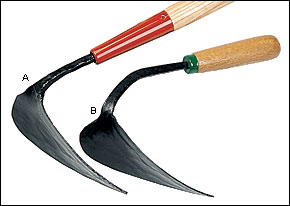
I LOVE this digger. It acts rather like a tiny plow when you drag it through soil, and it’s marvelous for loosening compacted soil, removing weeds, even digging furrows for dropping seeds in. However, as column readers will remember, it doesn’t handle being run over by a tractor lawnmower at all well. Here’s hoping my better half remembers that he owes me one…
Went into Topiary, a store for gardeners when I was in the always-irritating city of Halifax last week (irritating because of the greed of the parkingnazis in the downtown area, among other things), where I spent a delightful time, selecting gift suggestions to offer others as well as doing a little Christmas shopping. Topiary is a great store, with all sorts of delightful ideas for gardeners. I especially like that they have plenty of wonderful garden art, but also lots of birding ideas; as birding and gardening tend to go hand in hand. My longsuffering spouse ‘bought’ me one of James Chadwick’s metal crows (seen here perching on top of a birdseed wreath, almost too pretty to put out for the birds);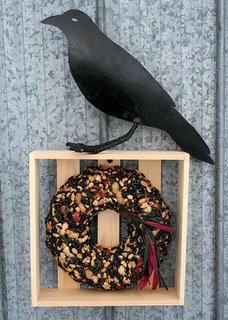 I bought it as a business expense but told him he could ‘give’ it to me early. He’s not getting off that easy on the digger, however.
I bought it as a business expense but told him he could ‘give’ it to me early. He’s not getting off that easy on the digger, however.
Speaking of birds, if you’re a birdwatcher/birdfeeder, I can highly recommend
For the Birds Nature shop in Mahone Bay. I ordered a gift for my longsuffering spouse from Kelly and Brian via their tollfree number, and it arrived THE NEXT DAY; it’s a perfect gift, too, and while I’m only about 90 minutes drive from Mahone Bay, I knew I wouldn’t have time to get there before Christmas. If you do visit the shop, it’s a delightful place to browse, but you can also browse online and find all their treasures; they offer free shipping, and as noted, it’s FAST!
Here’s my bit of self promotion. As some readers know, I wrote a gardening book last year. The Atlantic Gardener’s Greenbook has received positive reviews and feedback from those who have purchased it—or received it as a gift—and if anyone is unhappy with it, they haven’t let me know yet.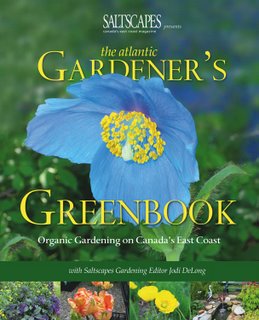 You can purchase the book directly from me (so I’ll actually make more than a few pennies from the sale—an ongoing problem that book authors find with royalty payments). You can contact me directly at jodi at bloomingwriter.ca (substitute @ and remove spaces) for details.
You can purchase the book directly from me (so I’ll actually make more than a few pennies from the sale—an ongoing problem that book authors find with royalty payments). You can contact me directly at jodi at bloomingwriter.ca (substitute @ and remove spaces) for details.
Most of us find ourselves with dry, cracked skin during the gardening season—even those gardeners among us who wear gloves when working outside. Is there anyone who can actually work in the garden with their gloves on all the time? I can’t do it, especially when thinning seedlings or planting small plants. So my hands invariably get dirty beyond belief, along with calloused, scratched, full of prickles, and so on. However, I slather on some of Naturally Nancy’s protective cream before I put my gloves on, or before I venture out without gloves (I regularly misplace my garden gloves, but usually find them again—at least, one of them).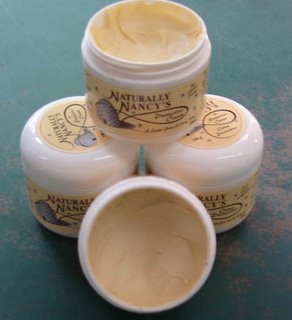 Nancy is a Nova Scotian landscaper who used to be plagued with terribly dry, cracked hands; so she developed a cream for herself using beeswax from her father’s beekeeping business. The cream worked so well, people began asking for it. It’s used for countless other purposes besides dry garden hands, but you can take my word—it does work. It’s unscented too.
Nancy is a Nova Scotian landscaper who used to be plagued with terribly dry, cracked hands; so she developed a cream for herself using beeswax from her father’s beekeeping business. The cream worked so well, people began asking for it. It’s used for countless other purposes besides dry garden hands, but you can take my word—it does work. It’s unscented too.
Now, I’m not sensitive to scents, and my favourite scent in the world is lavender—real lavender, that is, not the artificial perfumes developed by so many businesses. That’s why I was so excited to discover Beach Lane Lavender about two years ago. They’re also Nova Scotian owned and operated, and their lavender products, including lip balms and skin creams, are glorious—and truly lavender. I get their Maritime men’s aftershave for my dear other half, and he loves it too—not too flowery, but clean-scented and great on his delicate skin.
A final thought for today. Instead of mailing out Christmas cards this year, I’ve decided to give a gift that really matters. We spend a fair bit on Christmas cards and postage, to say nothing of the time spent writing notes, addressing envelopes, and mailing these out; I’d rather do something that will help someone else. So I’ve decided to purchase meaningful gifts from World Vision; instead of sending cards. 35.00 buys two rabbits; 50.00, two hens and a rooster; and these go to people in developing countries who need our help more than my friends need cards from me. Unlike some charitable organizations that pool their monetary donations even though they say you’re buying X with it, World Vision does genuinely use my donation to put the gifts I purchase into the hands of those who need them.
The only thing not to give as a gardening Christmas gift?
Goutweed, of course.
I’m joking, of course. You already know my opinions on the latest trends in Christmas décor.
What to give as gifts? Well, in my world, of course, almost all things gardening are treasured gifts, both to give and receive. I wrote about some of them in my latest Chronicle Herald column, but that will only be online until next Sunday, and of course I couldn’t include everything that I thought of, or every photo. Mind you, I don’t have a say in which photos get published. So here are a few more suggestions, plus a small bit of self-promotion, which I hope readers will understand. More on that anon.
First off: If you live in or near a city that has a Lee Valley store, there are almost infinite numbers of choices there for great gardening gifts. There are tools of every possible sort, including my absolute favourite, the Korean ho-mi digger.

I LOVE this digger. It acts rather like a tiny plow when you drag it through soil, and it’s marvelous for loosening compacted soil, removing weeds, even digging furrows for dropping seeds in. However, as column readers will remember, it doesn’t handle being run over by a tractor lawnmower at all well. Here’s hoping my better half remembers that he owes me one…
Went into Topiary, a store for gardeners when I was in the always-irritating city of Halifax last week (irritating because of the greed of the parkingnazis in the downtown area, among other things), where I spent a delightful time, selecting gift suggestions to offer others as well as doing a little Christmas shopping. Topiary is a great store, with all sorts of delightful ideas for gardeners. I especially like that they have plenty of wonderful garden art, but also lots of birding ideas; as birding and gardening tend to go hand in hand. My longsuffering spouse ‘bought’ me one of James Chadwick’s metal crows (seen here perching on top of a birdseed wreath, almost too pretty to put out for the birds);
 I bought it as a business expense but told him he could ‘give’ it to me early. He’s not getting off that easy on the digger, however.
I bought it as a business expense but told him he could ‘give’ it to me early. He’s not getting off that easy on the digger, however. Speaking of birds, if you’re a birdwatcher/birdfeeder, I can highly recommend
For the Birds Nature shop in Mahone Bay. I ordered a gift for my longsuffering spouse from Kelly and Brian via their tollfree number, and it arrived THE NEXT DAY; it’s a perfect gift, too, and while I’m only about 90 minutes drive from Mahone Bay, I knew I wouldn’t have time to get there before Christmas. If you do visit the shop, it’s a delightful place to browse, but you can also browse online and find all their treasures; they offer free shipping, and as noted, it’s FAST!
Here’s my bit of self promotion. As some readers know, I wrote a gardening book last year. The Atlantic Gardener’s Greenbook has received positive reviews and feedback from those who have purchased it—or received it as a gift—and if anyone is unhappy with it, they haven’t let me know yet.
 You can purchase the book directly from me (so I’ll actually make more than a few pennies from the sale—an ongoing problem that book authors find with royalty payments). You can contact me directly at jodi at bloomingwriter.ca (substitute @ and remove spaces) for details.
You can purchase the book directly from me (so I’ll actually make more than a few pennies from the sale—an ongoing problem that book authors find with royalty payments). You can contact me directly at jodi at bloomingwriter.ca (substitute @ and remove spaces) for details. Most of us find ourselves with dry, cracked skin during the gardening season—even those gardeners among us who wear gloves when working outside. Is there anyone who can actually work in the garden with their gloves on all the time? I can’t do it, especially when thinning seedlings or planting small plants. So my hands invariably get dirty beyond belief, along with calloused, scratched, full of prickles, and so on. However, I slather on some of Naturally Nancy’s protective cream before I put my gloves on, or before I venture out without gloves (I regularly misplace my garden gloves, but usually find them again—at least, one of them).
 Nancy is a Nova Scotian landscaper who used to be plagued with terribly dry, cracked hands; so she developed a cream for herself using beeswax from her father’s beekeeping business. The cream worked so well, people began asking for it. It’s used for countless other purposes besides dry garden hands, but you can take my word—it does work. It’s unscented too.
Nancy is a Nova Scotian landscaper who used to be plagued with terribly dry, cracked hands; so she developed a cream for herself using beeswax from her father’s beekeeping business. The cream worked so well, people began asking for it. It’s used for countless other purposes besides dry garden hands, but you can take my word—it does work. It’s unscented too. Now, I’m not sensitive to scents, and my favourite scent in the world is lavender—real lavender, that is, not the artificial perfumes developed by so many businesses. That’s why I was so excited to discover Beach Lane Lavender about two years ago. They’re also Nova Scotian owned and operated, and their lavender products, including lip balms and skin creams, are glorious—and truly lavender. I get their Maritime men’s aftershave for my dear other half, and he loves it too—not too flowery, but clean-scented and great on his delicate skin.
A final thought for today. Instead of mailing out Christmas cards this year, I’ve decided to give a gift that really matters. We spend a fair bit on Christmas cards and postage, to say nothing of the time spent writing notes, addressing envelopes, and mailing these out; I’d rather do something that will help someone else. So I’ve decided to purchase meaningful gifts from World Vision; instead of sending cards. 35.00 buys two rabbits; 50.00, two hens and a rooster; and these go to people in developing countries who need our help more than my friends need cards from me. Unlike some charitable organizations that pool their monetary donations even though they say you’re buying X with it, World Vision does genuinely use my donation to put the gifts I purchase into the hands of those who need them.
The only thing not to give as a gardening Christmas gift?
Goutweed, of course.
07 December 2006
Taking "Blue Christmas" one step too far...
Be warned: this is a bit of a rant.
I’ve seen it all, now.
I thought my friend Alice was joking when she told me she had seen blue poinsettias in wallyworld, the bigbox bully that is trying to decimate small town Canada, having already pillaged small town America.
Blue poinsettias? Oh, she must mean silk ones. I’d already seen tacky black artificial poinsettias, to go along with the incredibly ugly black and white Christmas décor that someone deemed trendy for this year. More on that later.
But no, her email seemed to indicate REAL plants.
So, ever the intrepid gardener in search of the real dirt on such things, I girded up my loins, sallied forth into the commercial wilderness that is between Kentville and Wolfville, and waded into the throngs of unwashed masses eager to spend their last dollar on plastic junk from Wallyworld. (Why IS it so many people don’t bother to shower, wash, or use deoderant—and then go out in public?)
And there they were. Not only blue poinsettias, but a sickly mauve coloured crop too. Most of them half wilted, obviously traumatized by having been offloaded in a chill gale of Nova Scotia wind before being stuffed into a lightless, airless, overheated department store.
Oh, my. Are we approaching botanical Armageddon?
They’re absolutely hideous. Well, that’s my opinion. Apparently there are people who think these are the next best thing to wonderbread. Why, is beyond me. These aren’t genuine, genetically blue flowers; they’re dyed with some sort of floral dye to give them the colour. And not just available in blue, oh no. You can get gold, (for the harvest season, no doubt) lilac, fuchsia, green, and gawdknows how many other colours. Hey, probably even BLACK for the goth celebrants.
Now, I am a fan of new colours in plants when it’s due to breeding, crossbreeding, and so on. After all, who more than me loves the new echinaceas, or searches for the deepest purple or most brilliant gold foliage in shrubs and perennials? And I have loved the new advances in poinsettia colours; the deeper burgundies, the bicolours and marbles, the lemon-chiffon, the variegated leaves…
But these blue and other-hued poinsettias look ghastly; especially so when some benighted floral ‘designer’ decides to tart them up further with glitter or iridescent spangles. Doesn’t this look like something out of a dollar store clearance bin?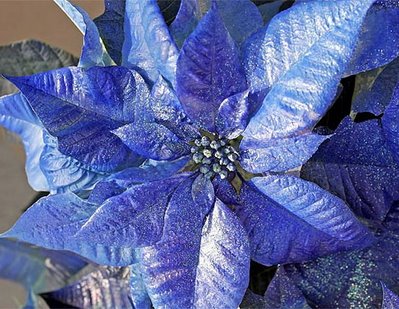
Okay, maybe I’m being harsh. Chacun on son gout, we all say. Fair enough; if someone wants a blue poinsettia, they can fill their boots.
But wait, there’s more. These blue poinsettias in a bigbox store in a Nova Scotian town—they were at least grown in Nova Scotia, right?
Wrongo. They are labeled “Product of Ohio.” Talk about pouring salt into the wounds. We have a fantastic nursery here in the province that grows huge numbers of poinsettias. That wholesales to all kinds of other nurseries and stores. And yet wallyworld buys its from an Excited State and hauls them up here to die in Nova Scotia?
Steady, jodi, steady. Deep breaths, girl. On to something else while I’m in my grinch-like mode.
What braintrust decided that we needed BLACK Christmas decorations? I don’t mean décor celebrating African heritage. I mean the colour black. Black ornaments. Black silk flowers—including, surprise surprise, poinsettias. Black table runners, swags, tinsels, probably even lights? Even black Christmas TREES! (Artificial, thankfully, so far—no sprayed balsam fir or scotch pine trees to be found so far…) It seems to have been a European trend which some designer-diva decided needed to be imported across the ocean to sully our shores. Paired with white, of course, for the tres chic, avante garde look. Oooh, lah lah. Pass me my glass of black champagne, darling, while I deck the halls with black holly with white berries.
Oh please. I was willing to go with the introduction of copper, bronze, purple, turquoise into the Christmas colour palette, though some of the more neon colours make me cringe. I saw a tree decorated in peacock colours that appealed to me as a curio, but not as something I’d want sitting in my living room for two weeks.
But black? The only things black and white I want to see at Christmas is licorice allsorts, and penguin-themed items like calendars and coffee mugs. Not ornaments, not trees, and definitely not poinsettias.
What’s next? Tied dyed Christmas trees? Orange-foliaged Holly shrubs with neon pink berries?
I’ve seen it all, now.
I thought my friend Alice was joking when she told me she had seen blue poinsettias in wallyworld, the bigbox bully that is trying to decimate small town Canada, having already pillaged small town America.
Blue poinsettias? Oh, she must mean silk ones. I’d already seen tacky black artificial poinsettias, to go along with the incredibly ugly black and white Christmas décor that someone deemed trendy for this year. More on that later.
But no, her email seemed to indicate REAL plants.
So, ever the intrepid gardener in search of the real dirt on such things, I girded up my loins, sallied forth into the commercial wilderness that is between Kentville and Wolfville, and waded into the throngs of unwashed masses eager to spend their last dollar on plastic junk from Wallyworld. (Why IS it so many people don’t bother to shower, wash, or use deoderant—and then go out in public?)
And there they were. Not only blue poinsettias, but a sickly mauve coloured crop too. Most of them half wilted, obviously traumatized by having been offloaded in a chill gale of Nova Scotia wind before being stuffed into a lightless, airless, overheated department store.
Oh, my. Are we approaching botanical Armageddon?
They’re absolutely hideous. Well, that’s my opinion. Apparently there are people who think these are the next best thing to wonderbread. Why, is beyond me. These aren’t genuine, genetically blue flowers; they’re dyed with some sort of floral dye to give them the colour. And not just available in blue, oh no. You can get gold, (for the harvest season, no doubt) lilac, fuchsia, green, and gawdknows how many other colours. Hey, probably even BLACK for the goth celebrants.
Now, I am a fan of new colours in plants when it’s due to breeding, crossbreeding, and so on. After all, who more than me loves the new echinaceas, or searches for the deepest purple or most brilliant gold foliage in shrubs and perennials? And I have loved the new advances in poinsettia colours; the deeper burgundies, the bicolours and marbles, the lemon-chiffon, the variegated leaves…
But these blue and other-hued poinsettias look ghastly; especially so when some benighted floral ‘designer’ decides to tart them up further with glitter or iridescent spangles. Doesn’t this look like something out of a dollar store clearance bin?

Okay, maybe I’m being harsh. Chacun on son gout, we all say. Fair enough; if someone wants a blue poinsettia, they can fill their boots.
But wait, there’s more. These blue poinsettias in a bigbox store in a Nova Scotian town—they were at least grown in Nova Scotia, right?
Wrongo. They are labeled “Product of Ohio.” Talk about pouring salt into the wounds. We have a fantastic nursery here in the province that grows huge numbers of poinsettias. That wholesales to all kinds of other nurseries and stores. And yet wallyworld buys its from an Excited State and hauls them up here to die in Nova Scotia?
Steady, jodi, steady. Deep breaths, girl. On to something else while I’m in my grinch-like mode.
What braintrust decided that we needed BLACK Christmas decorations? I don’t mean décor celebrating African heritage. I mean the colour black. Black ornaments. Black silk flowers—including, surprise surprise, poinsettias. Black table runners, swags, tinsels, probably even lights? Even black Christmas TREES! (Artificial, thankfully, so far—no sprayed balsam fir or scotch pine trees to be found so far…) It seems to have been a European trend which some designer-diva decided needed to be imported across the ocean to sully our shores. Paired with white, of course, for the tres chic, avante garde look. Oooh, lah lah. Pass me my glass of black champagne, darling, while I deck the halls with black holly with white berries.
Oh please. I was willing to go with the introduction of copper, bronze, purple, turquoise into the Christmas colour palette, though some of the more neon colours make me cringe. I saw a tree decorated in peacock colours that appealed to me as a curio, but not as something I’d want sitting in my living room for two weeks.
But black? The only things black and white I want to see at Christmas is licorice allsorts, and penguin-themed items like calendars and coffee mugs. Not ornaments, not trees, and definitely not poinsettias.
What’s next? Tied dyed Christmas trees? Orange-foliaged Holly shrubs with neon pink berries?
28 November 2006
Sunlight and the gardener's soul
During a marathon garden cleanup over several of the few sunny days we’ve experienced in November, I’ve managed to get two beds more or less cleaned up, and about 90 percent of the bulbs are now tucked in the ground too. Of course, at the time I thought I had them all in…but then Blomidon Nurseries put their bulbs on sale, and I was in there looking for something else, and some more species tulips, crocus and alliums looked pleadingly at me…whatever could I do?
And even though a lot of the real showy tulips can only be treated as annuals in our climate, I have planted a lot again this year. Some of them are Triumph and Darwin tulips, which do come back for a few years; others, I simply must have because they are good for my gardening soul. Apricot Parrot is one of them. I was hooked instantly on this tulip when I saw it grown in a pot at Ouestville Perennials
in the spring of 2005; I’ve planted a dozen together with Spring Green tulips, which are a refreshing white and green combination. This will give me something very nice to anticipate for next spring.
I’ve planted a dozen together with Spring Green tulips, which are a refreshing white and green combination. This will give me something very nice to anticipate for next spring.
I’m a bit late in putting entries on bloomingwriter because I was away working last week; spent a couple of days in New Brunswick, including a wonderful stay at the Inn on the Cove & Spa.
 If I could swing it, I’d go there overnight at least once a month because this is most decidedly an escape from the ordinary and hectic demands of life. Located, as its name suggests, right on a quiet cove in Saint John, it’s the ideal stress reliever. From the kingsized bed and Jacuzzi tub in my room—with its own patio looking out on the Bay—to the marvelous meals prepared by Ross Mavis, the owner and chef, to the utter decadence of a treatment at the spa, it was an exercise in pure relaxation and restoration. I left feeling most decidedly like a better person—or at least, a person who was feeling much better! And yes, even in November, it’s a gorgeous spot.
If I could swing it, I’d go there overnight at least once a month because this is most decidedly an escape from the ordinary and hectic demands of life. Located, as its name suggests, right on a quiet cove in Saint John, it’s the ideal stress reliever. From the kingsized bed and Jacuzzi tub in my room—with its own patio looking out on the Bay—to the marvelous meals prepared by Ross Mavis, the owner and chef, to the utter decadence of a treatment at the spa, it was an exercise in pure relaxation and restoration. I left feeling most decidedly like a better person—or at least, a person who was feeling much better! And yes, even in November, it’s a gorgeous spot. 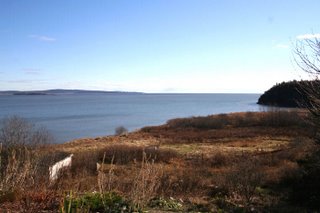 I took a stroll on the stony beach and picked up a couple of lower Bay of Fundy pebbles for the garden here, and at night, turned off the heat in my room and opened the window so I could listen to the most beautiful music in the world—the sound of waves tumbling in to shore.
I took a stroll on the stony beach and picked up a couple of lower Bay of Fundy pebbles for the garden here, and at night, turned off the heat in my room and opened the window so I could listen to the most beautiful music in the world—the sound of waves tumbling in to shore.
Back to reality and my own yard, however, is always pleasant. We’ve finally had a couple of hard frosts but despite that, some annuals close to the house keep right on growing—and even flowering, in the case of one enthusiastic snapdragon. One of the pot cyclamen is blooming out under the spruce trees, an amazing splash of fuchsia among the deep rich greens of hellebores, wild ginger, and slowly winding-down ferns. But the plant that has most caught my love this fall (other than the heathers, about which I’ll say more later) is this wonderful euphorbia that I planted last spring. I’ve extolled its virtues before, but as the autumn stretches towards solstice and it still is gorgeous, I grow to love it even more.
Unfortuntately, I still don’t know which one it is—as it’s suffering from LOLA syndrome—Lost Label. I do know that I got it at Spencer’s Nursery in Shelburne, so perhaps some kind soul will set me straight on its species and cultivar. Whatever it is, it’s a winner in my books.
And even though a lot of the real showy tulips can only be treated as annuals in our climate, I have planted a lot again this year. Some of them are Triumph and Darwin tulips, which do come back for a few years; others, I simply must have because they are good for my gardening soul. Apricot Parrot is one of them. I was hooked instantly on this tulip when I saw it grown in a pot at Ouestville Perennials
in the spring of 2005;
 I’ve planted a dozen together with Spring Green tulips, which are a refreshing white and green combination. This will give me something very nice to anticipate for next spring.
I’ve planted a dozen together with Spring Green tulips, which are a refreshing white and green combination. This will give me something very nice to anticipate for next spring. I’m a bit late in putting entries on bloomingwriter because I was away working last week; spent a couple of days in New Brunswick, including a wonderful stay at the Inn on the Cove & Spa.
 If I could swing it, I’d go there overnight at least once a month because this is most decidedly an escape from the ordinary and hectic demands of life. Located, as its name suggests, right on a quiet cove in Saint John, it’s the ideal stress reliever. From the kingsized bed and Jacuzzi tub in my room—with its own patio looking out on the Bay—to the marvelous meals prepared by Ross Mavis, the owner and chef, to the utter decadence of a treatment at the spa, it was an exercise in pure relaxation and restoration. I left feeling most decidedly like a better person—or at least, a person who was feeling much better! And yes, even in November, it’s a gorgeous spot.
If I could swing it, I’d go there overnight at least once a month because this is most decidedly an escape from the ordinary and hectic demands of life. Located, as its name suggests, right on a quiet cove in Saint John, it’s the ideal stress reliever. From the kingsized bed and Jacuzzi tub in my room—with its own patio looking out on the Bay—to the marvelous meals prepared by Ross Mavis, the owner and chef, to the utter decadence of a treatment at the spa, it was an exercise in pure relaxation and restoration. I left feeling most decidedly like a better person—or at least, a person who was feeling much better! And yes, even in November, it’s a gorgeous spot.  I took a stroll on the stony beach and picked up a couple of lower Bay of Fundy pebbles for the garden here, and at night, turned off the heat in my room and opened the window so I could listen to the most beautiful music in the world—the sound of waves tumbling in to shore.
I took a stroll on the stony beach and picked up a couple of lower Bay of Fundy pebbles for the garden here, and at night, turned off the heat in my room and opened the window so I could listen to the most beautiful music in the world—the sound of waves tumbling in to shore. Back to reality and my own yard, however, is always pleasant. We’ve finally had a couple of hard frosts but despite that, some annuals close to the house keep right on growing—and even flowering, in the case of one enthusiastic snapdragon. One of the pot cyclamen is blooming out under the spruce trees, an amazing splash of fuchsia among the deep rich greens of hellebores, wild ginger, and slowly winding-down ferns. But the plant that has most caught my love this fall (other than the heathers, about which I’ll say more later) is this wonderful euphorbia that I planted last spring. I’ve extolled its virtues before, but as the autumn stretches towards solstice and it still is gorgeous, I grow to love it even more.

Unfortuntately, I still don’t know which one it is—as it’s suffering from LOLA syndrome—Lost Label. I do know that I got it at Spencer’s Nursery in Shelburne, so perhaps some kind soul will set me straight on its species and cultivar. Whatever it is, it’s a winner in my books.
11 November 2006
The continuing tale of hollyhock woe
Confession is good for the gardener’s soul, and I’m never one to shy away from admitting my gardening mistakes—whoops, that’s supposed to read experiments. Real gardeners have experiments, not mistakes, right?
Well, whatever the case, here’s my ongoing tale of woe regarding hollyhocks.
I love hollyhocks. Their old fashioned beauty makes me very happy, and I keep having visions of having a great host of them, up against the house, blooming in all kinds of colours, but especially yellow. I crave yellow hollyhocks, whether single or double.
Trouble is, the garden fates don’t seem to want me to have them.
It’s true that growing hollyhocks is a bit of a challenge in our garden. Oh, they’ll germinate well enough, and grow the first year; but that heavy wet cold clay soil of ours does them in after one too many freeze-thaw cycles, or one too many monsoons in early spring. The hollyhocks generally turn to slimy mush underground, and there we have it. I’ve even tried buying them as transplants, and occasionally have had successes, but usually only with plants that are potbound and prepared to flower because they’re stressed.
However, I’m nothing if not stubborn, and keep trying different areas in the garden. I finally hit on two beds that drain quite well and have tried seeding and putting in transplants in these beds. Last year, a spectacular plant developed and grew with vast amounts of enthusiasm…but bore white flowers.
This would have been okay but for the fact that yes, it was supposed to be yellow.
Before that plant showed its treacherous self, I bought a few transplants that were labeled as yellow, and put them in for this year in several different areas of the garden. When the white ones appeared, I was nonplussed but hoped that the labeled yellow transplants—bought at a garden centre, even—would survive the winter and finally give me my yellow hollyhocks. I wasn’t greedy. I figured if I got one to come into flower, I’d simply keep its seed and put them everywhere.
This year, the first plants to wake up grew enormously—they’re currently about 11 feet tall—and produced all kinds of marvelous, fat buds…
which opened up pink. Very pink. They are delightful, single flowers, and have charmed hummingbirds and butterflies and visitors alike. But they are most certainly pink.
In fact, I checked that plant today, and while one of the spires has toppled, there are all kinds of new leaves, and yet another flower spike is starting to grown. Apparently this plant doesn’t realize it’s November. I figure it will cast seeds everywhere and I’ll be overrun with pink hollyhocks for the next zillion years.
Another plant plant, off by itself in another bed, sheltered somewhat by shrubs. It was slow to get going, and I wondered if it was a seedling…except there was a tag beside it proclaiming it to be a double yellow hollyhock. Eventually it had a cluster of buds, about which I grew excited as they grew in size. They were showing yellow—definitely yellow. I thought victory was finally mine.
Until the day my longsuffering spouse came in the house and announced, “Your hollyhock is open…and it’s peach coloured.”
No way. I flew out the door, scattering cats and plant pots, across the yard to the plant. The buds were still showing distinctly yellow, but the half-opened flower wasn’t really yellow. It wasn’t really peach, either.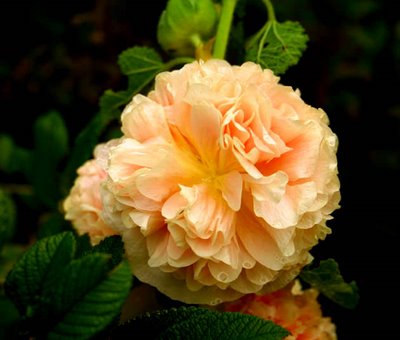 We argued about it, and finally, out of desperation, I proclaimed it to be orange.
We argued about it, and finally, out of desperation, I proclaimed it to be orange.
“There is no such thing as an orange hollyhock,” my spouse reminded me.
There is now. At least, in our garden.
Now, it’s entirely possible that this is an apricot hollyhock, because I know that such a colour does exist. And transferring the photo I took to the Web doesn't even do the colour justice--must not be a web-happy colour! But I’m in such a snit, even a month after that plant finished blooming, that I’m hoping it sheds a few seeds and presents me with more orange-flowered plants next year. Then at least I’ll have something interesting and bizarre.
Of course, many gardeners have already heard my tale of hollyhock woe in the past, and have been very encouraging, although occasionally a bit smug too. Even my own mother gleefully reported having a gorgeous double yellow plant in her garden. However, gardeners are also a generous lot and have started giving me seeds of yellow hollyhocks. They mail them to me, give them to me when I visited them, even drop them off at our house with a flower to prove that they came from a yellow flowered plant. I’ve planted them all, but I’m beginning to think I’m destined to never have one.
Or maybe we’ll develop a blue one.
That’s my story and I’m sticking to it.
Well, whatever the case, here’s my ongoing tale of woe regarding hollyhocks.
I love hollyhocks. Their old fashioned beauty makes me very happy, and I keep having visions of having a great host of them, up against the house, blooming in all kinds of colours, but especially yellow. I crave yellow hollyhocks, whether single or double.
Trouble is, the garden fates don’t seem to want me to have them.
It’s true that growing hollyhocks is a bit of a challenge in our garden. Oh, they’ll germinate well enough, and grow the first year; but that heavy wet cold clay soil of ours does them in after one too many freeze-thaw cycles, or one too many monsoons in early spring. The hollyhocks generally turn to slimy mush underground, and there we have it. I’ve even tried buying them as transplants, and occasionally have had successes, but usually only with plants that are potbound and prepared to flower because they’re stressed.
However, I’m nothing if not stubborn, and keep trying different areas in the garden. I finally hit on two beds that drain quite well and have tried seeding and putting in transplants in these beds. Last year, a spectacular plant developed and grew with vast amounts of enthusiasm…but bore white flowers.
This would have been okay but for the fact that yes, it was supposed to be yellow.
Before that plant showed its treacherous self, I bought a few transplants that were labeled as yellow, and put them in for this year in several different areas of the garden. When the white ones appeared, I was nonplussed but hoped that the labeled yellow transplants—bought at a garden centre, even—would survive the winter and finally give me my yellow hollyhocks. I wasn’t greedy. I figured if I got one to come into flower, I’d simply keep its seed and put them everywhere.
This year, the first plants to wake up grew enormously—they’re currently about 11 feet tall—and produced all kinds of marvelous, fat buds…
which opened up pink. Very pink. They are delightful, single flowers, and have charmed hummingbirds and butterflies and visitors alike. But they are most certainly pink.
In fact, I checked that plant today, and while one of the spires has toppled, there are all kinds of new leaves, and yet another flower spike is starting to grown. Apparently this plant doesn’t realize it’s November. I figure it will cast seeds everywhere and I’ll be overrun with pink hollyhocks for the next zillion years.
Another plant plant, off by itself in another bed, sheltered somewhat by shrubs. It was slow to get going, and I wondered if it was a seedling…except there was a tag beside it proclaiming it to be a double yellow hollyhock. Eventually it had a cluster of buds, about which I grew excited as they grew in size. They were showing yellow—definitely yellow. I thought victory was finally mine.
Until the day my longsuffering spouse came in the house and announced, “Your hollyhock is open…and it’s peach coloured.”
No way. I flew out the door, scattering cats and plant pots, across the yard to the plant. The buds were still showing distinctly yellow, but the half-opened flower wasn’t really yellow. It wasn’t really peach, either.
 We argued about it, and finally, out of desperation, I proclaimed it to be orange.
We argued about it, and finally, out of desperation, I proclaimed it to be orange.“There is no such thing as an orange hollyhock,” my spouse reminded me.
There is now. At least, in our garden.
Now, it’s entirely possible that this is an apricot hollyhock, because I know that such a colour does exist. And transferring the photo I took to the Web doesn't even do the colour justice--must not be a web-happy colour! But I’m in such a snit, even a month after that plant finished blooming, that I’m hoping it sheds a few seeds and presents me with more orange-flowered plants next year. Then at least I’ll have something interesting and bizarre.
Of course, many gardeners have already heard my tale of hollyhock woe in the past, and have been very encouraging, although occasionally a bit smug too. Even my own mother gleefully reported having a gorgeous double yellow plant in her garden. However, gardeners are also a generous lot and have started giving me seeds of yellow hollyhocks. They mail them to me, give them to me when I visited them, even drop them off at our house with a flower to prove that they came from a yellow flowered plant. I’ve planted them all, but I’m beginning to think I’m destined to never have one.
Or maybe we’ll develop a blue one.
That’s my story and I’m sticking to it.
05 November 2006
Flurries where winds blow on shore...
That’s an often-heard prognostication made by Maritime weather forecasters, trying to justify all the science and computer generated models and other gadgetry used to tell us what we’re going to have for weather. Consulting the entrails of a chicken might be just as effective, given the accuracy of weather forecasts around here.
It’s hard to make judgment calls about weather systems overall when there are such a variety of microclimates, even in one part of one province. In summer, the Annapolis Valley may be shimmering with heat, but come up over the mountain to the Fundy shore, and you may find yourself wrapped in fog, with at least 15 degrees (Fahrenheit) difference in temperature.
In fall and winter, we’re often subject to that curious phenomenon of flurries where winds blow on shore—and those flurries can accumulate to serious inches of snow. So when I looked out the window this afternoon and saw the flurries, I grabbed my camera and took a picture of a typically bleak Fundy day in the NO month of November.
Then something caught my eye in the garden, something I hadn’t noticed when I was doing a bit of much-needed cleanup the other day. I pulled on a sweater and boots and traipsed out to have a look.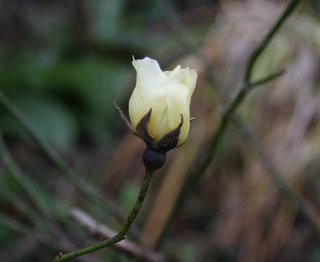
Yup, your eyes do NOT deceive you. This, dear friends and gentle gardeners, is the bud of a Golden Wings rose. There are actually two of them on the same branch, shimmering bright against the dying of the light, and the coldness of the Norwest wind coming in off the Bay.
They gave me hope, as blooms always do, that we’ll yet have a few nice days. In fact, Friday was a decent day, when the skies were blue and the light golden and the play of light on larch and pine made me intensely happy, if only for a few hours (while the sun was out.) And looking at this photo again, my heart with pleasure fills, just like William Wordsworth. True, there are no daffodils to dance through at this time, but still and all…there is beauty around us to lift the heart.

One of my favourite autumn sights is looking down from the Wellington dyke towards Blomidon, across cornfields, apple orchards, the dykelands around the mudflats, with the brooding edge of Cape Blomidon in the background. I’m always struck with wonder whenever I look at the dykelands that hold back the Minas Basin from flooding huge sections of the Annapolis Valley. The sense of history catches me, every time, as the dykes and aboiteaux were initially built and maintained by the Acadians who farmed and developed this land beginning 400 years ago with the establishment of Port Royal further down the valley and the Bay. The dykes and aboiteaux, or sluiceways, that work on the tidal rivers are maintained today by different methods and with different materials, but still they hold back the waters, claiming thousands of acres of arable farmland that would otherwise be underwater.
And I hear, too, the whispers of ghosts, the ghosts of Acadian settlers long gone, expulsed from this their homeland and scattered in their own Diaspora. And though I’m not Acadian, I pause to give respect to those first settlers, farmers, woodsmen, craftswomen, families…always remembering them, in sun or in snow.

It’s hard to make judgment calls about weather systems overall when there are such a variety of microclimates, even in one part of one province. In summer, the Annapolis Valley may be shimmering with heat, but come up over the mountain to the Fundy shore, and you may find yourself wrapped in fog, with at least 15 degrees (Fahrenheit) difference in temperature.
In fall and winter, we’re often subject to that curious phenomenon of flurries where winds blow on shore—and those flurries can accumulate to serious inches of snow. So when I looked out the window this afternoon and saw the flurries, I grabbed my camera and took a picture of a typically bleak Fundy day in the NO month of November.

Then something caught my eye in the garden, something I hadn’t noticed when I was doing a bit of much-needed cleanup the other day. I pulled on a sweater and boots and traipsed out to have a look.

Yup, your eyes do NOT deceive you. This, dear friends and gentle gardeners, is the bud of a Golden Wings rose. There are actually two of them on the same branch, shimmering bright against the dying of the light, and the coldness of the Norwest wind coming in off the Bay.
They gave me hope, as blooms always do, that we’ll yet have a few nice days. In fact, Friday was a decent day, when the skies were blue and the light golden and the play of light on larch and pine made me intensely happy, if only for a few hours (while the sun was out.) And looking at this photo again, my heart with pleasure fills, just like William Wordsworth. True, there are no daffodils to dance through at this time, but still and all…there is beauty around us to lift the heart.

One of my favourite autumn sights is looking down from the Wellington dyke towards Blomidon, across cornfields, apple orchards, the dykelands around the mudflats, with the brooding edge of Cape Blomidon in the background. I’m always struck with wonder whenever I look at the dykelands that hold back the Minas Basin from flooding huge sections of the Annapolis Valley. The sense of history catches me, every time, as the dykes and aboiteaux were initially built and maintained by the Acadians who farmed and developed this land beginning 400 years ago with the establishment of Port Royal further down the valley and the Bay. The dykes and aboiteaux, or sluiceways, that work on the tidal rivers are maintained today by different methods and with different materials, but still they hold back the waters, claiming thousands of acres of arable farmland that would otherwise be underwater.
And I hear, too, the whispers of ghosts, the ghosts of Acadian settlers long gone, expulsed from this their homeland and scattered in their own Diaspora. And though I’m not Acadian, I pause to give respect to those first settlers, farmers, woodsmen, craftswomen, families…always remembering them, in sun or in snow.

01 November 2006
Requiem for a mentor
Well. After four days of gale force winds shaking the house and stripping most leaves from trees and shrubs, the wind finally exhausted itself last night. A gentle calm descended....
...and so did the fog. An interesting way to start November.
I got some sad news last week, and am just finding time now to write about it. One of my professors from my days at the Nova Scotia Agricultural College, Dr. Lorne A. McFadden, passed away a couple of weeks ago in Truro after an apparently fairly lengthy illness.
Lorne was directly responsible, along with his colleague Albert E. (Doc) Roland, for my development as a plant nut. He taught botany and plant pathology at the AC, and while he was on sabbatical when I took botany in first year, he became more than a professor to me--he became a mentor who encouraged me, and almost a friend. When he wasn't teaching and I wasn't in class, we would spend long periods of time talking about plants, plant diseases, treatments for diseases, weed control....all things to do with the mysteries of plants.
Even then, I was interested in organic gardening/farming, biological control, native plants and such. When in our plant pathology course we had to write a paper on a disease of a crop, I asked "Dr. M" if I could do an essay on biological control of plant pathogens--a topic scarcely discussed back then. He was totally agreeable, and I got an A on the paper--it was actually a mark, and I forget the mark, but an A for sure.
He always encouraged such thought and study in me, and when I decided to leave one program and transfer into plant science, he wrote a very supportive letter to the dean asking that I be allowed to change programs. He got me summer employment at the College, and put in a word for me for parttime work during the class year. He lent me books, answered questions, and was one of the two best teachers I had in my assorted years of post secondary study. (the other one was an English professor at Acadia)
And I'm only one of thousands of students he taught over the years, and one of many who he inspired and encouraged on to bigger and better things.
Lorne was a prodigious gardener, as I got to see once when a fellow professor, one I worked for as a summer student, was leaving to pursue Ph.D studies at Guelph. There was a going away party for Bob at Lorne's house, and I remember spending more time out in the garden looking at plants than with people.
It's been years since I've seen Dr. M--after he retired, I don't know that he ever visited the biology department, and on my infrequent trips to Truro, I wasn't inclined to visit a professor's home--even though several professors have become friends of mine over the years. The details of his illness are unknown to me, and in fact I missed his obituary when it ran in our newspaper; I only found out when my mother mentioned it to me on the phone a week ago.
I haven't decided what shrub I'll plant in his memory next spring, but there certainly will be one. Goodbye, Dr. M, you were one of the best, and i'll ever be grateful for your enthusiasm and encouragement.
...and so did the fog. An interesting way to start November.
I got some sad news last week, and am just finding time now to write about it. One of my professors from my days at the Nova Scotia Agricultural College, Dr. Lorne A. McFadden, passed away a couple of weeks ago in Truro after an apparently fairly lengthy illness.
Lorne was directly responsible, along with his colleague Albert E. (Doc) Roland, for my development as a plant nut. He taught botany and plant pathology at the AC, and while he was on sabbatical when I took botany in first year, he became more than a professor to me--he became a mentor who encouraged me, and almost a friend. When he wasn't teaching and I wasn't in class, we would spend long periods of time talking about plants, plant diseases, treatments for diseases, weed control....all things to do with the mysteries of plants.
Even then, I was interested in organic gardening/farming, biological control, native plants and such. When in our plant pathology course we had to write a paper on a disease of a crop, I asked "Dr. M" if I could do an essay on biological control of plant pathogens--a topic scarcely discussed back then. He was totally agreeable, and I got an A on the paper--it was actually a mark, and I forget the mark, but an A for sure.
He always encouraged such thought and study in me, and when I decided to leave one program and transfer into plant science, he wrote a very supportive letter to the dean asking that I be allowed to change programs. He got me summer employment at the College, and put in a word for me for parttime work during the class year. He lent me books, answered questions, and was one of the two best teachers I had in my assorted years of post secondary study. (the other one was an English professor at Acadia)
And I'm only one of thousands of students he taught over the years, and one of many who he inspired and encouraged on to bigger and better things.
Lorne was a prodigious gardener, as I got to see once when a fellow professor, one I worked for as a summer student, was leaving to pursue Ph.D studies at Guelph. There was a going away party for Bob at Lorne's house, and I remember spending more time out in the garden looking at plants than with people.
It's been years since I've seen Dr. M--after he retired, I don't know that he ever visited the biology department, and on my infrequent trips to Truro, I wasn't inclined to visit a professor's home--even though several professors have become friends of mine over the years. The details of his illness are unknown to me, and in fact I missed his obituary when it ran in our newspaper; I only found out when my mother mentioned it to me on the phone a week ago.
I haven't decided what shrub I'll plant in his memory next spring, but there certainly will be one. Goodbye, Dr. M, you were one of the best, and i'll ever be grateful for your enthusiasm and encouragement.
24 October 2006
blog-lag, jet-lag--err, train-lag--and autumn denial
Nice to know that I'm loved--or at least, that some folks enjoy reading my bloggy wanderings. I've had several emails in the last week, wondering where the heck I've been. Had the goutweed finally turned into Audrey from Little Shop of Horrors and decide I was dinner? Had the cats carried me off to a land of warm weather and many mice? Or had I been swept off on another garden adventure?
None of the above, as fun as they might be. Well, except for the goutweed part.
I've been busier than usual since getting back from my whirlwind garden adventures in upalong--hard to believe that this time three weeks ago, I was dozing on the train en route homewards! Self employment has its challenges, and sometimes we bite off more than we can chew. In that case, we circle the wagons, and less important things get set aside. Housework, laundry, paperwork, non-work email...even...GASP!...the garden.
Yes, it's true. I've been shamefully neglectful the past week or so, scarcely walking around out there in my peaceful green haven.
Now, we can blame that partly on the weather. Sadly, the monsoons of autumn have arrived--not that this is a tropical location, far from it, but every autumn the wind begins to moan and scream and we get scads of rain. And days that aren't rainy are still dreary, overcast, bonechillingly damp and achycold and just plain misery-making. So instead of being outside I hug the stove or hide in my office and console myself with garden related things on walls and shelves, and scarcely even look outdoors.
Days the sun comes out are much better; but the sun sleeps in much later in the mornings and is quick to turn in at evening--and in less than a week, the clocks go back, yuck. It'll be dark by 1730 then, and I will want to hibernate.
But I won't. There are still plenty of things to talk about with regards to gardening Always. Like the state of my houseplants. Some of them look radiant after their summer spent outside on the deck. Others are sulking the change in venue by dropping lots of leaves and getting dry edges to the leaves that are staying on--tropicals aren't designed for a normal household unless you have a solarium or a big bathroom where they'll get the necessary moisture and humidity.
I have one terracotta planter that is quite hilarious, actually. It holds one black plant and one silver plant. To be precise, one black mondo grass(Opiophogon) and one Silver sand (Calocephalus). This looked really stunning outside on the deck all summer, where the Silver sand looked like some ethereal plant from another planet, and was perfectly contrasted by the almost black leaves of the mondo, which is actually a lily relative rather than a grass. Because the mondo grass isn't hardy to my zone, and because I'd never seen silver sand before and want to see what will happen to it over winter, I brought the planter indoors.
Problem. The mondo grass, which was looking rather lush and healthy and profuse, is now looking ratty.
The problem is the furbucket brigade that live with us. Some of the cats discovered that mondo grass is quite tasty. At least, it must be, because they go after it like a shot every time they're in my office visiting. Spunky Boomerang and Simon Q Snark are the most naughty in ths regard, chomping on the grasslike leaves every chance they get. It's apparently not toxic--unlike dogs which are dumb as stumps IMHO, cats seem to know what is toxic and leave those plants alone--and while they do bother a few other plants--they ADORE spider plants!--they sure are intent on dining on this one whenever possible.
There's another mondo grass out in the garden, sunk into the ground in a pot. I may have to bring that one in, and hang it up in a window...and hope that Toby Soprano, the flying bosscat of this here family, doesn't do one of his acrobatic leaps into the planter. Imagine what all that cat hair will look like woven in among a jute macreme hanger! Scary for sure.
Oh look...I've forgotten that I'm mad at autumn. Talking about plants or cats will do that for me.
More soon, I promise. Photos too.
None of the above, as fun as they might be. Well, except for the goutweed part.
I've been busier than usual since getting back from my whirlwind garden adventures in upalong--hard to believe that this time three weeks ago, I was dozing on the train en route homewards! Self employment has its challenges, and sometimes we bite off more than we can chew. In that case, we circle the wagons, and less important things get set aside. Housework, laundry, paperwork, non-work email...even...GASP!...the garden.
Yes, it's true. I've been shamefully neglectful the past week or so, scarcely walking around out there in my peaceful green haven.
Now, we can blame that partly on the weather. Sadly, the monsoons of autumn have arrived--not that this is a tropical location, far from it, but every autumn the wind begins to moan and scream and we get scads of rain. And days that aren't rainy are still dreary, overcast, bonechillingly damp and achycold and just plain misery-making. So instead of being outside I hug the stove or hide in my office and console myself with garden related things on walls and shelves, and scarcely even look outdoors.
Days the sun comes out are much better; but the sun sleeps in much later in the mornings and is quick to turn in at evening--and in less than a week, the clocks go back, yuck. It'll be dark by 1730 then, and I will want to hibernate.
But I won't. There are still plenty of things to talk about with regards to gardening Always. Like the state of my houseplants. Some of them look radiant after their summer spent outside on the deck. Others are sulking the change in venue by dropping lots of leaves and getting dry edges to the leaves that are staying on--tropicals aren't designed for a normal household unless you have a solarium or a big bathroom where they'll get the necessary moisture and humidity.
I have one terracotta planter that is quite hilarious, actually. It holds one black plant and one silver plant. To be precise, one black mondo grass(Opiophogon) and one Silver sand (Calocephalus). This looked really stunning outside on the deck all summer, where the Silver sand looked like some ethereal plant from another planet, and was perfectly contrasted by the almost black leaves of the mondo, which is actually a lily relative rather than a grass. Because the mondo grass isn't hardy to my zone, and because I'd never seen silver sand before and want to see what will happen to it over winter, I brought the planter indoors.
Problem. The mondo grass, which was looking rather lush and healthy and profuse, is now looking ratty.
The problem is the furbucket brigade that live with us. Some of the cats discovered that mondo grass is quite tasty. At least, it must be, because they go after it like a shot every time they're in my office visiting. Spunky Boomerang and Simon Q Snark are the most naughty in ths regard, chomping on the grasslike leaves every chance they get. It's apparently not toxic--unlike dogs which are dumb as stumps IMHO, cats seem to know what is toxic and leave those plants alone--and while they do bother a few other plants--they ADORE spider plants!--they sure are intent on dining on this one whenever possible.
There's another mondo grass out in the garden, sunk into the ground in a pot. I may have to bring that one in, and hang it up in a window...and hope that Toby Soprano, the flying bosscat of this here family, doesn't do one of his acrobatic leaps into the planter. Imagine what all that cat hair will look like woven in among a jute macreme hanger! Scary for sure.
Oh look...I've forgotten that I'm mad at autumn. Talking about plants or cats will do that for me.
More soon, I promise. Photos too.
05 October 2006
If it's Sunday, I must be in....Windsor?
Well, that’s about how I felt on Sunday morning, after getting into Windsor late Saturday night. Nice surprise at the Hilton when I got there—along with a great information package about the city and its parks, etc, there was a lovely bottle of locally produced Late Harvest Vidal…which I’ve faithfully tucked away in my bag to bring home to share with my better half. And my room was on the 21st floor, looking out on the Detroit River, the Ambassador Bridge, and Detroit. Wow….a nice place to visit but I wouldn’t wanna live there, though. It’s the flattest part of the country I’ve ever seen next to the Prairies, of course. And in fact, this part of southwestern Ontario is the edge of what was once a mighty tallgrass prairie! I didn’t know that, not until I read the package of information waiting for me at the Hilton when I arrived on Saturday night. The remnants of this once mighty ecosystem are under protection at the Ojibway Prairie Provincial Natural Preserve, located on the edge of Windsor. Of course, I could see none of this from my hotel window, on the 21st floor of the hotel, overlooking the Detroit River, the Ambassador Bridge, and of course, Detroit. 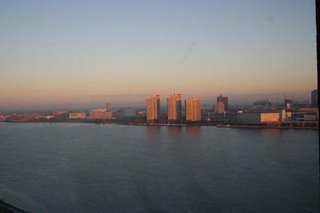
If Windsor and Detroit are sister cities, Windsor is obviously the beautiful sister. What an attractive, green, and clean city this is! I spent more time exploring Windsor than I did anywhere on the rest of my trip except Burlington, and liked what I saw. I had a guided tour all day Sunday courtesy of the Director of Parks, Don Sadler, and his partner Lou Ann Barnett, a professional photographer from whom I could learn a lot, if I could follow her around for a few days. They picked me up Sunday morning and proceeded to show me everything from the incredibly lovely riverside gardens to a couple of nature parks to several recreation parks to distinctive formal gardens to that tallgrass prairie. And I was smitten.
Windsor is a city of around 200,000, and while there have been some hardtimes courtesy of the downturn of the American car manufacturing industry, this is a city that loves its public green spaces. And not only that, the community supports that love with financial backing, so that the parks and green spaces and athletic fields are well tended, beautifully groomed in fact—and done so using green gardening techniques as much as possible. Put a city beside a lovely waterway—and there’s swimming at public spaces along the way—and clean up the waterfront to become a series of parks and gardens, and it’s amazing how people will flock to use it. On weekdays, office workers fill the parking lots as they take a break to walk through the gardens and along the waterfront; on the weekend, it’s family time, with scores of people out with their children, young couples dreaming their way along the waterfront…and there’s no litter to be seen! People actually use the large but discreet garbage bins! I was delighted by that, being accustomed to seeing the disrespect shown in some communities for public spaces.
The riverside gardens include three main areas; Reaume Park and Coventry Gardens, and features something for everyone. Children enjoy hunting through the gardens to find the various topiary sculptures of animals from dogs to dragons; the huge floating fountain, the Charlie Brooks Memorial Peace Fountain, creates more than 2 dozen spray patterns as it throws water high into the air; the gardens are full of imaginative plantings, using a wide variety of annuals, perennials, shrubs, and even tender perennials and tropicals (which go indoors for the winter, of course.) Further along is a wildflower garden, then the Bert Weeks Memorial Garden, built in honour of a former mayor. This place was incredible—well planted with perennial grasses, which were in full bloom and song when I visited, and which provided a wonderful counterpoint to the sound of music from the huge water feature called the reflecting pool. At the river’s edge is an interesting brick structure, which now is used to pump water not to the community but to irrigate the gardens along the river.
the gardens are full of imaginative plantings, using a wide variety of annuals, perennials, shrubs, and even tender perennials and tropicals (which go indoors for the winter, of course.) Further along is a wildflower garden, then the Bert Weeks Memorial Garden, built in honour of a former mayor. This place was incredible—well planted with perennial grasses, which were in full bloom and song when I visited, and which provided a wonderful counterpoint to the sound of music from the huge water feature called the reflecting pool. At the river’s edge is an interesting brick structure, which now is used to pump water not to the community but to irrigate the gardens along the river.
 Naturally, I was entranced by the whole riverside garden experience, but there was far more. Further along Riverside Drive is Odette Sculpture Park, which is dedicated to a generous number of modern art sculptures. There are two totem poles, bronzes of horses and humans, wire sculpture, and my favourite—penguins!
Naturally, I was entranced by the whole riverside garden experience, but there was far more. Further along Riverside Drive is Odette Sculpture Park, which is dedicated to a generous number of modern art sculptures. There are two totem poles, bronzes of horses and humans, wire sculpture, and my favourite—penguins!
One thing about Windsor—it’s a flat, flat city. There are two hills in the entire city, and both of those are manmade, reclaimed areas that are natural parks with trails for runners and cyclists and others to enjoy. We went to the top of both these hills, (Malden and Ganatchio) and could survey not only the city, but across the river to Detroit! Naturally, one of these hills is much loved as a toboggan run in winter—when there is snow that lasts any amount of time, of course, because this is a mild-wintered part of the country.
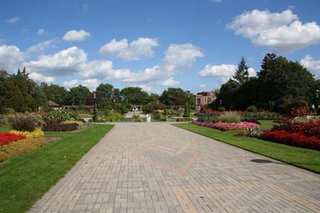 From the wild beauty of Ojibway and Malden and the Ganatchio Trail, we went to a completely different area: Jackson Park, dedicated by Queen Elizabeth some years ago, and featuring formal gardens and walkways (perfect for wedding pictures) and several war memorials to veterans. That was a particularly striking sight—there are two replica planes in one section of the garden, a Spitfire and a Hurricane.
From the wild beauty of Ojibway and Malden and the Ganatchio Trail, we went to a completely different area: Jackson Park, dedicated by Queen Elizabeth some years ago, and featuring formal gardens and walkways (perfect for wedding pictures) and several war memorials to veterans. That was a particularly striking sight—there are two replica planes in one section of the garden, a Spitfire and a Hurricane. 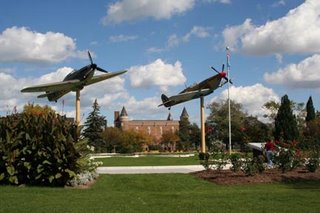 The third, a Lancaster, is being restored and is to be located in another park, but its silhouette has been outlined on the ground under the two planes, a haunting echo and a moving tribute to the sacrifice made by so many. Seems highly appropriate especially given our current state of affairs in Afghanistan.
The third, a Lancaster, is being restored and is to be located in another park, but its silhouette has been outlined on the ground under the two planes, a haunting echo and a moving tribute to the sacrifice made by so many. Seems highly appropriate especially given our current state of affairs in Afghanistan.
There was almost too much to take in all in one day in Windsor—were I planning another trip, I would spend no less than two days in each of the cities I visited on this trip, and more if I could. It would be hard to pick a favourite site, either in Windsor or on the whole trip, so I won’t—I enjoyed all of them for different reasons, as each is very good at what it does.
After an early supper, I returned to my room to download another 150 or so photos, and pack up for a very early morning. Two days on trains, basically, brought me through Ontario and Quebec and back into the Maritimes via the Ocean again. About Miramichi, however, I decided I was getting restless to be on the ground again, and called my longsuffering spouse to meet me in Truro. It’s always wonderful to go away—and this was an exceptionally fine trip—but it’s even more wonderful to see my darling other half standing on the platform waiting for me. And be it ever so humble, there’s no garden quite like our own, is there?

If Windsor and Detroit are sister cities, Windsor is obviously the beautiful sister. What an attractive, green, and clean city this is! I spent more time exploring Windsor than I did anywhere on the rest of my trip except Burlington, and liked what I saw. I had a guided tour all day Sunday courtesy of the Director of Parks, Don Sadler, and his partner Lou Ann Barnett, a professional photographer from whom I could learn a lot, if I could follow her around for a few days. They picked me up Sunday morning and proceeded to show me everything from the incredibly lovely riverside gardens to a couple of nature parks to several recreation parks to distinctive formal gardens to that tallgrass prairie. And I was smitten.

Windsor is a city of around 200,000, and while there have been some hardtimes courtesy of the downturn of the American car manufacturing industry, this is a city that loves its public green spaces. And not only that, the community supports that love with financial backing, so that the parks and green spaces and athletic fields are well tended, beautifully groomed in fact—and done so using green gardening techniques as much as possible. Put a city beside a lovely waterway—and there’s swimming at public spaces along the way—and clean up the waterfront to become a series of parks and gardens, and it’s amazing how people will flock to use it. On weekdays, office workers fill the parking lots as they take a break to walk through the gardens and along the waterfront; on the weekend, it’s family time, with scores of people out with their children, young couples dreaming their way along the waterfront…and there’s no litter to be seen! People actually use the large but discreet garbage bins! I was delighted by that, being accustomed to seeing the disrespect shown in some communities for public spaces.
The riverside gardens include three main areas; Reaume Park and Coventry Gardens, and features something for everyone. Children enjoy hunting through the gardens to find the various topiary sculptures of animals from dogs to dragons; the huge floating fountain, the Charlie Brooks Memorial Peace Fountain, creates more than 2 dozen spray patterns as it throws water high into the air;
 the gardens are full of imaginative plantings, using a wide variety of annuals, perennials, shrubs, and even tender perennials and tropicals (which go indoors for the winter, of course.) Further along is a wildflower garden, then the Bert Weeks Memorial Garden, built in honour of a former mayor. This place was incredible—well planted with perennial grasses, which were in full bloom and song when I visited, and which provided a wonderful counterpoint to the sound of music from the huge water feature called the reflecting pool. At the river’s edge is an interesting brick structure, which now is used to pump water not to the community but to irrigate the gardens along the river.
the gardens are full of imaginative plantings, using a wide variety of annuals, perennials, shrubs, and even tender perennials and tropicals (which go indoors for the winter, of course.) Further along is a wildflower garden, then the Bert Weeks Memorial Garden, built in honour of a former mayor. This place was incredible—well planted with perennial grasses, which were in full bloom and song when I visited, and which provided a wonderful counterpoint to the sound of music from the huge water feature called the reflecting pool. At the river’s edge is an interesting brick structure, which now is used to pump water not to the community but to irrigate the gardens along the river. Naturally, I was entranced by the whole riverside garden experience, but there was far more. Further along Riverside Drive is Odette Sculpture Park, which is dedicated to a generous number of modern art sculptures. There are two totem poles, bronzes of horses and humans, wire sculpture, and my favourite—penguins!
Naturally, I was entranced by the whole riverside garden experience, but there was far more. Further along Riverside Drive is Odette Sculpture Park, which is dedicated to a generous number of modern art sculptures. There are two totem poles, bronzes of horses and humans, wire sculpture, and my favourite—penguins! One thing about Windsor—it’s a flat, flat city. There are two hills in the entire city, and both of those are manmade, reclaimed areas that are natural parks with trails for runners and cyclists and others to enjoy. We went to the top of both these hills, (Malden and Ganatchio) and could survey not only the city, but across the river to Detroit! Naturally, one of these hills is much loved as a toboggan run in winter—when there is snow that lasts any amount of time, of course, because this is a mild-wintered part of the country.
 From the wild beauty of Ojibway and Malden and the Ganatchio Trail, we went to a completely different area: Jackson Park, dedicated by Queen Elizabeth some years ago, and featuring formal gardens and walkways (perfect for wedding pictures) and several war memorials to veterans. That was a particularly striking sight—there are two replica planes in one section of the garden, a Spitfire and a Hurricane.
From the wild beauty of Ojibway and Malden and the Ganatchio Trail, we went to a completely different area: Jackson Park, dedicated by Queen Elizabeth some years ago, and featuring formal gardens and walkways (perfect for wedding pictures) and several war memorials to veterans. That was a particularly striking sight—there are two replica planes in one section of the garden, a Spitfire and a Hurricane.  The third, a Lancaster, is being restored and is to be located in another park, but its silhouette has been outlined on the ground under the two planes, a haunting echo and a moving tribute to the sacrifice made by so many. Seems highly appropriate especially given our current state of affairs in Afghanistan.
The third, a Lancaster, is being restored and is to be located in another park, but its silhouette has been outlined on the ground under the two planes, a haunting echo and a moving tribute to the sacrifice made by so many. Seems highly appropriate especially given our current state of affairs in Afghanistan. There was almost too much to take in all in one day in Windsor—were I planning another trip, I would spend no less than two days in each of the cities I visited on this trip, and more if I could. It would be hard to pick a favourite site, either in Windsor or on the whole trip, so I won’t—I enjoyed all of them for different reasons, as each is very good at what it does.
After an early supper, I returned to my room to download another 150 or so photos, and pack up for a very early morning. Two days on trains, basically, brought me through Ontario and Quebec and back into the Maritimes via the Ocean again. About Miramichi, however, I decided I was getting restless to be on the ground again, and called my longsuffering spouse to meet me in Truro. It’s always wonderful to go away—and this was an exceptionally fine trip—but it’s even more wonderful to see my darling other half standing on the platform waiting for me. And be it ever so humble, there’s no garden quite like our own, is there?
04 October 2006
From rocks to wetlands to neon to Niagara
High on my list of places you gotta go is the Royal Botanical Gardens, located in Burlington/Hamilton. What a great time I had visiting this time. In 2005 I was in Hamilton for PWAC’s Annual General Meeting, and got to see a bit of the gardens, but not nearly enough. This time, however, I got a pretty thorough visit of much of the site, which is actually spread out over several different locales around the edge of Hamilton/Burlington.
Last time, I was at the Rock Gardens in late May, and they were awash in colour from the 100,000 plus bulbs, mostly tulips, planted there. Big sweeps of colour, vibrant and jewellike; now of course that garden is planted with a host of annuals to provide equal drifts of colour, and those will be coming out soon for the bulb planting session. The Rock Garden is neat because it’s set down in this hollow with huge, native rock structures on the hills of the “bowl”—nice dramatic rocks, and since this is part of the Niagara Escarpment, it’s hardly surprising to find rocks there.
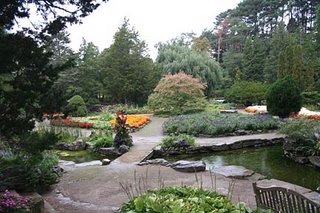
It was built 75 years ago in what was an abandoned gravel pit, using local limestone—a great make-work project to help counteract the grim reality of the Depression. There aren’t only annuals and bulbs here, howeve—there are some wonderful water features, mature trees and shrubs, (including magnolias and flowering cherries, rhodos and azaleas), and lots of steps and terraces to climb and view the garden from. It’s a peaceful and beautiful space, and much loved by the citizens of the area.
The RBG Centre is, of course, the place to start an entire tour of the Gardens. My host Andrew King and I had lunch in the Gardens Café, then headed to the Mediterranean Garden, an indoor collection under glass (and a perfect place to go during the grey days of winter.) There are huge specimens in here, ranging from false agave to banana (at least I think it was a banana!) flamboyant flowering plants such as bouganvillea, passion flower and bird of paradise, a fine display of cacti and succulents, and even wonderful citrus trees (all with fruit on them). Children can enjoy the outdoor Discovery Garden, which has all kinds of wonderful activities for them to help them get interested in gardening early.
Along with the usual displays of plants and structures, the Gardens were playing host to another unique display of beauty while I was there. ZimSculpt, a collection of Zimbabwean sculptures were nestled throughout Hendrie Park, looking like they had always been there--when in fact they were part of a touring exhibit--on its only stop in Canada--from that country, with the curator and three of the sculptors along for the trip, of course. They've spent a month in Burlington, have sold over 100,000 dollars worth of sculpture, and were hard at work making new pieces using single chunks of rock that they brought with them. Watching them was totally fascinating, and the sculptures were gorgeous...the tour is complete now, and they are heading homeward, but hopefully will be back again in the not too distant future.
Out the doors of the Centre, we enjoy the fountain court, where the cheery chiming of water from fountains provides the perfect anodyne to the rumble of nearby traffic. This terraced area is awash with annuals providing late season colour to push away even the dreariest of days—and it was dreary the day I visited. From there we walked into Hendrie Park, which is a huge, sprawling area with more than a dozen different theme gardens. The Centennial Rose Garden takes up a significant part of the Park, and you’d be surprised just how many roses are still blooming quite happily, even as we progress into October.
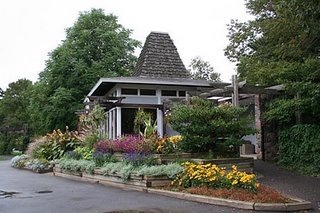
There are themed gardens for herbs and lilies, a wonderful medicinal garden, a clematis collection, more plots for children to enjoy, and the lovely tea house where you can pause and enjoy some refreshments before heading to the wild sanctuary of the woodland park known as Hendrie Valley Sanctuary. I loved this; we hiked down woodland trails, went through a clever fence designed to keep deer out of Hendrie Park proper, then across a lovely boardwalk over the wetlands area. What a pretty, peaceful spot; visitors were feeding wild birds, chipmunks and squirrels on the boardwalk rails, ducks were splashing and diving in a stream through the wetlands, and of course autumn glory was unfolding in the changing colours of hardwoods. Utterly lovely. We could have stayed a while, walked much further, but time was tickin’ by, and so we regretfully left this place and headed off to another site, Laking Garden.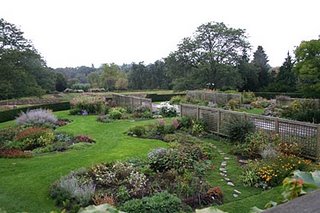
It was beginning to rain quite sincerely when we arrived at Laking, but we did pause to survey the domain from a lookout that gives the perfect view of the terraced gardens. The lowest terrace is currently a work in progress, as the iris beds are being converted from a series of rather dull beds to a more aesthetically appealing showcase for the some 600 cultivars of irises on display. I’d love to see THAT in flower—maybe another year! There’s a lovely old cottage at the top of the terraces, site of the Barbara Laking Heritage garden, which features many heirloom culticars of perennials and shrubs. The central terrace is dedicated to perennials, all kinds of perennials, including many new and improved cultivars. I really, REALLY enjoyed this area, despite the wet—well, I thought Laking in itself was pretty fine, a public spot any city would be proud to have, and yet it was only one section of the RBG.
By now, the rain was sincerely soggy, so my intrepid host suggested, as we had some three hours before my train, that we go off to Niagara to see the falls. It was too wet to go exploring gardens there and we knew we wouldn’t have that much time, but we sallied off down the highway and yakked a mile a minute about many things, while I gawked out windows at things like the Welland Canal, assorted vineyards, and such til we arrived in downtown Niagara Falls.
Well. What a strange place that is. Ever been there? Yikes! Clifton Hill is called the Entertainment and Dining district of Niagara Falls. I have one word to describe it—ultratacky! I’ve never seen so much neon, flashing lights, and bizarre displays enticing visitors; how about Frankenstein eating a burger on top of a fast food joint? King Kong hanging off another site? A wax museum—de rigeur in many tacky tourist traps—and of course, a plethora of casinos and nightclubs, all designed to separate the biker chicks, greaseballs, nearly destitute, nouveau riche and others from their money. I felt like I needed a shower just driving through the area. But you know what? It was all washed away, nearly literally, when we turned the corner and headed down to enjoy 12 dollar parking and the main attraction that gives the city its name—the real, genuine, and totally awesome Niagara Falls.
It’s hard to take a photo up close that shows the true magnificence and power of the Falls. All that energy, sound, fury, colour, cascading over the rapids and down over the dramatic drop to the river below. Utterly, completely mindblowingly wonderful. Never mind the horde of hotels on the hillside overlooking the Falls. Never mind the neon nightmare up the hill. Never mind the hordes of tacky souvenir shops. The falls are worth visiting, any time day or night.
And nyah, nyah, nyah nyah nyah, nyah…the Canadian falls are way, way more impressive than the wimpy American falls nearby. Ours are better than theirs….
Last time, I was at the Rock Gardens in late May, and they were awash in colour from the 100,000 plus bulbs, mostly tulips, planted there. Big sweeps of colour, vibrant and jewellike; now of course that garden is planted with a host of annuals to provide equal drifts of colour, and those will be coming out soon for the bulb planting session. The Rock Garden is neat because it’s set down in this hollow with huge, native rock structures on the hills of the “bowl”—nice dramatic rocks, and since this is part of the Niagara Escarpment, it’s hardly surprising to find rocks there.

It was built 75 years ago in what was an abandoned gravel pit, using local limestone—a great make-work project to help counteract the grim reality of the Depression. There aren’t only annuals and bulbs here, howeve—there are some wonderful water features, mature trees and shrubs, (including magnolias and flowering cherries, rhodos and azaleas), and lots of steps and terraces to climb and view the garden from. It’s a peaceful and beautiful space, and much loved by the citizens of the area.
The RBG Centre is, of course, the place to start an entire tour of the Gardens. My host Andrew King and I had lunch in the Gardens Café, then headed to the Mediterranean Garden, an indoor collection under glass (and a perfect place to go during the grey days of winter.) There are huge specimens in here, ranging from false agave to banana (at least I think it was a banana!) flamboyant flowering plants such as bouganvillea, passion flower and bird of paradise, a fine display of cacti and succulents, and even wonderful citrus trees (all with fruit on them). Children can enjoy the outdoor Discovery Garden, which has all kinds of wonderful activities for them to help them get interested in gardening early.
Along with the usual displays of plants and structures, the Gardens were playing host to another unique display of beauty while I was there. ZimSculpt, a collection of Zimbabwean sculptures were nestled throughout Hendrie Park, looking like they had always been there--when in fact they were part of a touring exhibit--on its only stop in Canada--from that country, with the curator and three of the sculptors along for the trip, of course. They've spent a month in Burlington, have sold over 100,000 dollars worth of sculpture, and were hard at work making new pieces using single chunks of rock that they brought with them. Watching them was totally fascinating, and the sculptures were gorgeous...the tour is complete now, and they are heading homeward, but hopefully will be back again in the not too distant future.
Out the doors of the Centre, we enjoy the fountain court, where the cheery chiming of water from fountains provides the perfect anodyne to the rumble of nearby traffic. This terraced area is awash with annuals providing late season colour to push away even the dreariest of days—and it was dreary the day I visited. From there we walked into Hendrie Park, which is a huge, sprawling area with more than a dozen different theme gardens. The Centennial Rose Garden takes up a significant part of the Park, and you’d be surprised just how many roses are still blooming quite happily, even as we progress into October.

There are themed gardens for herbs and lilies, a wonderful medicinal garden, a clematis collection, more plots for children to enjoy, and the lovely tea house where you can pause and enjoy some refreshments before heading to the wild sanctuary of the woodland park known as Hendrie Valley Sanctuary. I loved this; we hiked down woodland trails, went through a clever fence designed to keep deer out of Hendrie Park proper, then across a lovely boardwalk over the wetlands area. What a pretty, peaceful spot; visitors were feeding wild birds, chipmunks and squirrels on the boardwalk rails, ducks were splashing and diving in a stream through the wetlands, and of course autumn glory was unfolding in the changing colours of hardwoods. Utterly lovely. We could have stayed a while, walked much further, but time was tickin’ by, and so we regretfully left this place and headed off to another site, Laking Garden.

It was beginning to rain quite sincerely when we arrived at Laking, but we did pause to survey the domain from a lookout that gives the perfect view of the terraced gardens. The lowest terrace is currently a work in progress, as the iris beds are being converted from a series of rather dull beds to a more aesthetically appealing showcase for the some 600 cultivars of irises on display. I’d love to see THAT in flower—maybe another year! There’s a lovely old cottage at the top of the terraces, site of the Barbara Laking Heritage garden, which features many heirloom culticars of perennials and shrubs. The central terrace is dedicated to perennials, all kinds of perennials, including many new and improved cultivars. I really, REALLY enjoyed this area, despite the wet—well, I thought Laking in itself was pretty fine, a public spot any city would be proud to have, and yet it was only one section of the RBG.
By now, the rain was sincerely soggy, so my intrepid host suggested, as we had some three hours before my train, that we go off to Niagara to see the falls. It was too wet to go exploring gardens there and we knew we wouldn’t have that much time, but we sallied off down the highway and yakked a mile a minute about many things, while I gawked out windows at things like the Welland Canal, assorted vineyards, and such til we arrived in downtown Niagara Falls.
Well. What a strange place that is. Ever been there? Yikes! Clifton Hill is called the Entertainment and Dining district of Niagara Falls. I have one word to describe it—ultratacky! I’ve never seen so much neon, flashing lights, and bizarre displays enticing visitors; how about Frankenstein eating a burger on top of a fast food joint? King Kong hanging off another site? A wax museum—de rigeur in many tacky tourist traps—and of course, a plethora of casinos and nightclubs, all designed to separate the biker chicks, greaseballs, nearly destitute, nouveau riche and others from their money. I felt like I needed a shower just driving through the area. But you know what? It was all washed away, nearly literally, when we turned the corner and headed down to enjoy 12 dollar parking and the main attraction that gives the city its name—the real, genuine, and totally awesome Niagara Falls.
It’s hard to take a photo up close that shows the true magnificence and power of the Falls. All that energy, sound, fury, colour, cascading over the rapids and down over the dramatic drop to the river below. Utterly, completely mindblowingly wonderful. Never mind the horde of hotels on the hillside overlooking the Falls. Never mind the neon nightmare up the hill. Never mind the hordes of tacky souvenir shops. The falls are worth visiting, any time day or night.

And nyah, nyah, nyah nyah nyah, nyah…the Canadian falls are way, way more impressive than the wimpy American falls nearby. Ours are better than theirs….
01 October 2006
Toronto's Diva gets a facelift
 I’m a trooper when it comes to visiting gardens. After rolling into Toronto at nearly 11 pm, where the highlight of the trip was being met by my son Ryan, (newly moved to Toronto), I was up and going again by 745 the next morning. First I ‘rode the rocket’ of the Toronto subway to Eglinton, where a transfer to a bus took me down the road a few more miles to the Toronto Botanical Gardens at Lawrence Street East. There I found a surprise—these gardens are open to the public at no charge! In the courtyard nearest the main building, a group of seniors were drifting through the movements of tai chi. I wandered around for a little while before being met by my guide for the visit, a very nice man named (I think), Ken—a Friend of the Garden who volunteers regularly at the Music garden downtown at Harbourfront, but who also lives near the TBG and was willing to give up an hour or so of his Saturday morning to squire me around.
I’m a trooper when it comes to visiting gardens. After rolling into Toronto at nearly 11 pm, where the highlight of the trip was being met by my son Ryan, (newly moved to Toronto), I was up and going again by 745 the next morning. First I ‘rode the rocket’ of the Toronto subway to Eglinton, where a transfer to a bus took me down the road a few more miles to the Toronto Botanical Gardens at Lawrence Street East. There I found a surprise—these gardens are open to the public at no charge! In the courtyard nearest the main building, a group of seniors were drifting through the movements of tai chi. I wandered around for a little while before being met by my guide for the visit, a very nice man named (I think), Ken—a Friend of the Garden who volunteers regularly at the Music garden downtown at Harbourfront, but who also lives near the TBG and was willing to give up an hour or so of his Saturday morning to squire me around. Like many aging dowagers, the TBG is going through a period of rejuvenation. But in this case, it’s not liposuction and botox that is bringing this space back to its glory days, but the vision and dedication of its planners and planters. Much of the plantings now on display are new, tucked into the ground this spring, after a massive renovation of the grounds and the main building of the Gardens. There are twelve themed gardens in total, ranging from a very cool herb/kitchen garden, where each year a particular culture’s vegetables will be showcased, a terraced garden, a trial or show garden focusing on choice and sometimes unusual plants suitable for city gardening, a spiral mound (originally meant to be covered in thyme but currently grassed) from which you can view most of the Garden’s layout, and far more. Walkways are wide and most are paved, and there’s a lot to see in a compact locale—just like most Toronto yards, the Garden make the most of its available space.
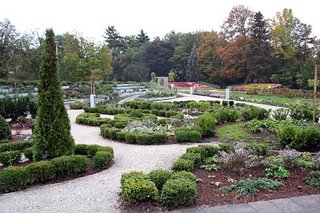
My host said that people are sometimes offput by the fact that the gardens aren’t all as full and lush as they expect—but I think this is actually excellent, because it also gives real gardeners, whether seasoned or new, a look at how a garden develops and grows over a period of time. After all, we all face this, especially when planting perennials, trees and shrubs—things look a little sparse initially. But I thought everything looked excellent. There are marvelous drifts of grasses near the entrance to the parking area; these look like they’ve been here for a while; then as we walk down the stone-paved paths towards the heart of the property, there is a wonderful planting that will, in time, look like a wildflower or prairie meadow planting, featuring some native as well as introduced species. There’s a unique long curving wall, built using a variety of materials from the portion of the building that was torn down for renovating, and planted with sempervivums and other groundcovering plants. Some think this planting resembles a train, or perhaps a slice of the Niagara Escarpment—I just know that it’s quite striking now and will be even moreso next year when it fills in further.
The two carpet bedding displays at one end of the Gardens acknowledge another garden, Edwards Gardens, which is a City of Toronto park. The TBG is a charitable organization, funded by generous patrons and donors around the city, and shares space, as it were, with the neighbouring Edward Gardens.

I didn’t have a whole lot of time to visit Edward, but looked longingly down a hill—one of Toronto’s famous ravines’ at mature trees, a lovely creek, walking trails and much more.
 The Garden Hall itself has areas that can be rented out, whether for weddings or other special events. Ajoining one part of the facility is the Floral Hall Courtyard, a screened in terrace also ideal for weddings and such. About this courtyard, I have to comment, because this is the third site in two days that I’ve seen featuring horsetails in a design. Not the irritating field horsetail, but the scouring rush, Equisetum hyemale, which DOES have a sort of Oriental quality to it and look really quite striking in a dedicated bed—bounded by stone so it can’t jump elsewhere.
The Garden Hall itself has areas that can be rented out, whether for weddings or other special events. Ajoining one part of the facility is the Floral Hall Courtyard, a screened in terrace also ideal for weddings and such. About this courtyard, I have to comment, because this is the third site in two days that I’ve seen featuring horsetails in a design. Not the irritating field horsetail, but the scouring rush, Equisetum hyemale, which DOES have a sort of Oriental quality to it and look really quite striking in a dedicated bed—bounded by stone so it can’t jump elsewhere. My only negative comment about my visit is that I hope that the TBG revises their website soon—it doesn’t display properly, is hard to navigate and has more administrative stuff on it than information about the gardens themselves, which is why I haven’t bothered adding a link to its URL in this entry.
One amusing aside—during my stay at the Fairmont Royal York, I opened a bottle of mineral water in my room, thinking it was the water they provide with their turndown service. Imagine my surprise when my son announced that he’d never SEEN an EIGHT DOLLAR bottle of water before! When I went to check out, I told the clerk to add the bottle to my tab (for Internet service—this is the only hotel I’ve stayed in in months that charges for high speed internet—a black mark on them) but she graciously dropped that charge and seemed somewhat embarrassed at the high price. I was more amused than annoyed, but was also touched by her thoughtfulness.
There are many more gardens throughout the city, including at the famed Casa Loma, which I'd originally been scheduled to visit but which was just not possible in the time allowed. Maybe I'll go some other time, although Toronto gets more than enough press without needing any from me. And yes, I'll confess right here--Toronto is still not my favourite city by a long shot, even if my son does live there!
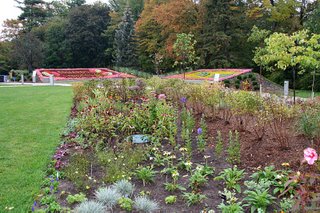
A leader first, a gardener at heart
I honestly didn’t know what to expect when I arrived in Ottawa, en route to visiting Kingsmere, Willam Lyon Mackenzie King’s estate, located in the heart of Gatineau Park, across the river from our nation’s capital. I had no idea that King, prime minister of Canada through three separate terms between 1921 and 1948, had been a lover of gardening since a young child, and at one time had wanted to be a landscaper. However, his parents also instilled in him a desire to serve his country, and hence his venture into political endeavours. We know that MacKenzie King was a dedicated Liberal who did much for this country—and I can’t help but think he spins in his grave when he sees what that bunch of Alliance wolves in cheap conservative clothing is doing to the country that he loved and served so well. Not a perfect leader, of course, as none are. When he died in 1950, King left his estate to the people of Canada.
After a not bad luncheon (though the service was abysmal) at the Moorside Tea Room, located in one of the summer houses on the estate, I went with my guide, Annie, around part of the estate. This area is at the top of quite a steep hill, much loved by cyclists, joggers, cross country skiers, and other outdoorsy types, and encompasses some 600 acres in total, some of it woodland, some of it resembling an English gentleman’s country estate—as King was a great fan of all things British, but more of a Romantic in tendancies than a late Victorian or Georgian. The houses didn’t particularly interest me, as architecture and old dishes, etc, aren’t particularly my thing but I did, of course, love the typewriter, on which King wrote many of his speeches.
but I did, of course, love the typewriter, on which King wrote many of his speeches.
What won my heart, where this interesting gentleman was concerned, was the wonderful stone walls throughout the property. King had these built during the depression, hiring local, unemployed individuals to do the work and earn a wage they would have otherwise been unlikely to find. The walls feature local indigenous rocks, mostly igneous in type, though I am no geologist so can’t really say what all of them are. Just that they were beautiful with rain on them.
Yeah, did I mention it was raining? Fortunately, Annie had provided me with both a jacket and an umbrella, but at times my lens did get smattered with water.
The perennial borders at the property are past their full glory, but still showing good colour, especially against the flaming backdrop of the hardwoods, which are just beginning to get really beautiful. This is a wonderful place to visit, to stroll across well kept grounds with all sorts of mature trees, as well as interesting stone ruins and relics and statuary that King had brought to the property and added to the landscaping. One long garden especially delighted me. At the top of it, (as it sweeps down a hill) is a massive piece of igneous stone, part of the local geology of an escarpment—a primitive, millions of year old nod to the country’s natural history and beginnings. Then there is a long English style perennial border, acknowledging that country’s place in our country’s development;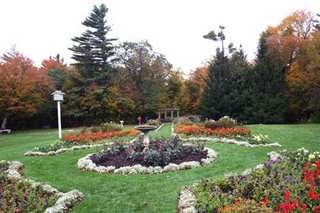 a stone archway which is a window on the woodlands looks down at native plants and natural plantings and a wonderful rock garden featuring alpine and hardy rock garden plants.
a stone archway which is a window on the woodlands looks down at native plants and natural plantings and a wonderful rock garden featuring alpine and hardy rock garden plants.
After this part of the tour, I was met by Francois LeDuc, who squired me around much of Gatineau Park proper. The park is over 380 square kilometers in size, with all kinds of landforms and geography, flora and fauna. At several places along the roads, there are incredible lookouts, the most dramatic one being at the top of the Escarpment looking down into the valley around Hull, Gatineau, Ottawa and Aylmer. And there are serious foliage fireworks happening—wow!
We took a drive to Meech Lake—yes, THAT Meech Lake, site of the failed accord—and followed the winding road along the series of three lakes in a chain. (there are something like 50 lakes in the park). Harrington Lake is site of the summer home of the prime minister, but we didn’t go up to the gates. Just as well, as I’d have had to show some sign of disrespect for that squinty eyed thug from Alberta…What struck me, once Francois drew it to my attention, was the careful pruning of the trees along the shores on the far side of the lakes…
…which, of course, is not pruning at all, at least not by human hands, but rather, by the teeth of deer.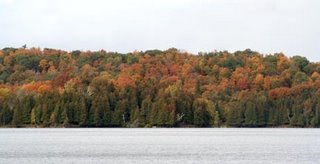 We saw a doe and two fawns on the roadside as we came down from the King estate, incidentally, as unconcerned about us as if we weren’t even there.
We saw a doe and two fawns on the roadside as we came down from the King estate, incidentally, as unconcerned about us as if we weren’t even there.
While I enjoyed this visit very much, I was also happy to get on the train again and head off down the road to Toronto. I’m so totally impressed with the service of VIA Rail—especially in first class. Let me give you all the menu from supper between Ottawa and Taranna—
Appetiser: melon and proscuitto; your choice of bread roll (with butter, not slimy margarine)
Main course; choice of three; I opted for braised beef, with tiny roasted potatoes, and a vegetable medly of fennel (delicious!), green beans, parsnips and red peppers; wine was an Ontario Riesling, I think (I forgot to write that down)
Dessert—an apple caramel cake, and then this chocolate in a chocolate cup—divine!
The staff came with wine several times, and then with liqueurs, even—Grand Marnier, cognac, Baileys, Tia Maria….I declined on that, but next time…I may treat myself.
And the staff is simply fantastic. This is an awesome way to travel!
Stiill, this is a hectic pace. Three gardens down, three cities to go.
After a not bad luncheon (though the service was abysmal) at the Moorside Tea Room, located in one of the summer houses on the estate, I went with my guide, Annie, around part of the estate. This area is at the top of quite a steep hill, much loved by cyclists, joggers, cross country skiers, and other outdoorsy types, and encompasses some 600 acres in total, some of it woodland, some of it resembling an English gentleman’s country estate—as King was a great fan of all things British, but more of a Romantic in tendancies than a late Victorian or Georgian. The houses didn’t particularly interest me, as architecture and old dishes, etc, aren’t particularly my thing
 but I did, of course, love the typewriter, on which King wrote many of his speeches.
but I did, of course, love the typewriter, on which King wrote many of his speeches. What won my heart, where this interesting gentleman was concerned, was the wonderful stone walls throughout the property. King had these built during the depression, hiring local, unemployed individuals to do the work and earn a wage they would have otherwise been unlikely to find. The walls feature local indigenous rocks, mostly igneous in type, though I am no geologist so can’t really say what all of them are. Just that they were beautiful with rain on them.
Yeah, did I mention it was raining? Fortunately, Annie had provided me with both a jacket and an umbrella, but at times my lens did get smattered with water.
The perennial borders at the property are past their full glory, but still showing good colour, especially against the flaming backdrop of the hardwoods, which are just beginning to get really beautiful. This is a wonderful place to visit, to stroll across well kept grounds with all sorts of mature trees, as well as interesting stone ruins and relics and statuary that King had brought to the property and added to the landscaping. One long garden especially delighted me. At the top of it, (as it sweeps down a hill) is a massive piece of igneous stone, part of the local geology of an escarpment—a primitive, millions of year old nod to the country’s natural history and beginnings. Then there is a long English style perennial border, acknowledging that country’s place in our country’s development;
 a stone archway which is a window on the woodlands looks down at native plants and natural plantings and a wonderful rock garden featuring alpine and hardy rock garden plants.
a stone archway which is a window on the woodlands looks down at native plants and natural plantings and a wonderful rock garden featuring alpine and hardy rock garden plants. After this part of the tour, I was met by Francois LeDuc, who squired me around much of Gatineau Park proper. The park is over 380 square kilometers in size, with all kinds of landforms and geography, flora and fauna. At several places along the roads, there are incredible lookouts, the most dramatic one being at the top of the Escarpment looking down into the valley around Hull, Gatineau, Ottawa and Aylmer. And there are serious foliage fireworks happening—wow!

We took a drive to Meech Lake—yes, THAT Meech Lake, site of the failed accord—and followed the winding road along the series of three lakes in a chain. (there are something like 50 lakes in the park). Harrington Lake is site of the summer home of the prime minister, but we didn’t go up to the gates. Just as well, as I’d have had to show some sign of disrespect for that squinty eyed thug from Alberta…What struck me, once Francois drew it to my attention, was the careful pruning of the trees along the shores on the far side of the lakes…
…which, of course, is not pruning at all, at least not by human hands, but rather, by the teeth of deer.
 We saw a doe and two fawns on the roadside as we came down from the King estate, incidentally, as unconcerned about us as if we weren’t even there.
We saw a doe and two fawns on the roadside as we came down from the King estate, incidentally, as unconcerned about us as if we weren’t even there. While I enjoyed this visit very much, I was also happy to get on the train again and head off down the road to Toronto. I’m so totally impressed with the service of VIA Rail—especially in first class. Let me give you all the menu from supper between Ottawa and Taranna—
Appetiser: melon and proscuitto; your choice of bread roll (with butter, not slimy margarine)
Main course; choice of three; I opted for braised beef, with tiny roasted potatoes, and a vegetable medly of fennel (delicious!), green beans, parsnips and red peppers; wine was an Ontario Riesling, I think (I forgot to write that down)
Dessert—an apple caramel cake, and then this chocolate in a chocolate cup—divine!
The staff came with wine several times, and then with liqueurs, even—Grand Marnier, cognac, Baileys, Tia Maria….I declined on that, but next time…I may treat myself.
And the staff is simply fantastic. This is an awesome way to travel!
Stiill, this is a hectic pace. Three gardens down, three cities to go.
Montreal's Other Masterpiece
Montreal’s second masterpiece

It’s a fairly long bus ride through the congestion of downtown Montreal, from the Midtown Holiday Inn (where I had to pout and threaten to call the trip organizer when I came to check in at 8 am after my 21 hour train ride before I could get my room) to the haven of tranquility that is the Jardin Botanique Montreal, or the Montreal Botanical Garden
Even though my energy was somewhat flagging after the train trip and then a spectacular time at Flora, I girded up my loins and my camera and prepared to see what this 75 year old public space had to offer.
And the answer is, quite a lot, of course.
From the traditional carpet bedding arrangement of annuals that greet visitors at the main entrance, to the zenful tranquility of the Japanese and Chinese gardens, from the rich woodlands of the Leslie rhododendron gardens to the flamboyant displays of perennials, childrens gardens and other themed gardens, this is a marvelous, and obviously well-utilized public space.
The Gardens were the dream of Brother Marie-Victorin back in the mid 1920s. (Incidentally, Agriculture Canada’s hardy rose series includes AC Marie-Victorin, a disease-resistant shrub rose introduced back in 1998.) When the dream was about to become a reality, unemployed people in Quebec were hired to build what has become a marvelous tribute to plants in the heart of the city.
They did well, and the dream continues to this day.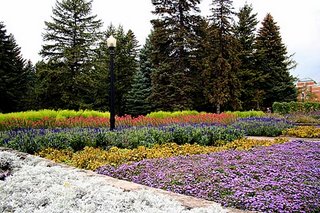
Currently, there’s a remarkable Chinese lantern show going on at the Gardens. While it really gets going at dusk and onwards, it’s worth visiting the Gardens at any time of the day just to see the incredible craftsmanship of these lanterns. They’re more than just your basic pagoda style lanterns, believe me! There are birds, fish, dragons, mythical creatures, lotus, people, all sculpted by artisans in Shanghai, China from silk specially treated to be water resistant, and the theme this year is celebrating Chinese holidays.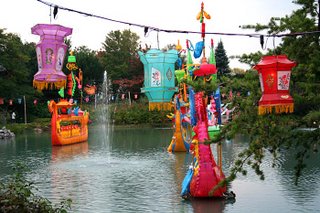 So you’ll see a dragon boat, a dragon dance, kites, and much, much more The colours are vibrant beyond words, and you can’t help but leave the garden feeling both relaxed and exhilarated at this glimpse of genuine Chinese culture. Incidentally, the Chinese garden at the Montreal Botanical Garden is apparently the largest one outside of Asia—quite an accomplishment, and one to be applauded.
So you’ll see a dragon boat, a dragon dance, kites, and much, much more The colours are vibrant beyond words, and you can’t help but leave the garden feeling both relaxed and exhilarated at this glimpse of genuine Chinese culture. Incidentally, the Chinese garden at the Montreal Botanical Garden is apparently the largest one outside of Asia—quite an accomplishment, and one to be applauded.
Bravo, Montreal, for all your horticultural triumphs.
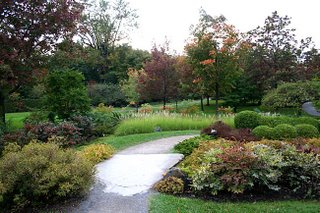

It’s a fairly long bus ride through the congestion of downtown Montreal, from the Midtown Holiday Inn (where I had to pout and threaten to call the trip organizer when I came to check in at 8 am after my 21 hour train ride before I could get my room) to the haven of tranquility that is the Jardin Botanique Montreal, or the Montreal Botanical Garden
Even though my energy was somewhat flagging after the train trip and then a spectacular time at Flora, I girded up my loins and my camera and prepared to see what this 75 year old public space had to offer.
And the answer is, quite a lot, of course.

From the traditional carpet bedding arrangement of annuals that greet visitors at the main entrance, to the zenful tranquility of the Japanese and Chinese gardens, from the rich woodlands of the Leslie rhododendron gardens to the flamboyant displays of perennials, childrens gardens and other themed gardens, this is a marvelous, and obviously well-utilized public space.
The Gardens were the dream of Brother Marie-Victorin back in the mid 1920s. (Incidentally, Agriculture Canada’s hardy rose series includes AC Marie-Victorin, a disease-resistant shrub rose introduced back in 1998.) When the dream was about to become a reality, unemployed people in Quebec were hired to build what has become a marvelous tribute to plants in the heart of the city.
They did well, and the dream continues to this day.

Currently, there’s a remarkable Chinese lantern show going on at the Gardens. While it really gets going at dusk and onwards, it’s worth visiting the Gardens at any time of the day just to see the incredible craftsmanship of these lanterns. They’re more than just your basic pagoda style lanterns, believe me! There are birds, fish, dragons, mythical creatures, lotus, people, all sculpted by artisans in Shanghai, China from silk specially treated to be water resistant, and the theme this year is celebrating Chinese holidays.
 So you’ll see a dragon boat, a dragon dance, kites, and much, much more The colours are vibrant beyond words, and you can’t help but leave the garden feeling both relaxed and exhilarated at this glimpse of genuine Chinese culture. Incidentally, the Chinese garden at the Montreal Botanical Garden is apparently the largest one outside of Asia—quite an accomplishment, and one to be applauded.
So you’ll see a dragon boat, a dragon dance, kites, and much, much more The colours are vibrant beyond words, and you can’t help but leave the garden feeling both relaxed and exhilarated at this glimpse of genuine Chinese culture. Incidentally, the Chinese garden at the Montreal Botanical Garden is apparently the largest one outside of Asia—quite an accomplishment, and one to be applauded. Bravo, Montreal, for all your horticultural triumphs.

28 September 2006
Live and in colour from Montreal
 If you’re going to be in Montreal in the next couple of weeks, you gotta go see Flora. If you’re not going to be there in that time, wait til next spring—then you gotta go see Flora.
If you’re going to be in Montreal in the next couple of weeks, you gotta go see Flora. If you’re not going to be there in that time, wait til next spring—then you gotta go see Flora.Flora who, you ask?
International Flora Montreal This has to be the most amazing garden themed display in the country. Now, I can’t claim to have been to every intriguing garden across the country—not by a long shot—but this is a phenomenal, breathtaking, and FUN exploration of gardening and garden design.
Why am I so besotted with this show?

In the first place, it’s a living, longterm display—this year from mid-June to mid-October—whereas shows like Canada Blooms are short flashes in the pan, here today, gone four days later. Come back to Flora week after week and see how the gardens change over the season.
VIA Rail came up with this wonderful travel theme called the Garden Route There are twelve gardens from Halifax to Windsor, Ontario, all accessible by one train route or another. The marvelous people who put on Flora, and the team at VIA, made it possible for me to go to Montreal, Ottawa, Toronto, Burlington/Hamilton and Windsor, to visit some of the gardens on the route. Naturally, I’ve already been to Halifax’s Public Gardens, and to Kingsbrae in New Brunswick—another of those “You GOTTA go” places—but I did cartwheels, figuratively if not literally, when I was asked to go. And it didn’t take long to get me packed and into Halifax to meet my train.
I love trains. I despise flying now, especially since Canjet is no more—sure, flying is fast, but it reminds me of moving livestock, crammed into too—small quarters. Give me a train any day of the week, provided I’ve got the time to take to travel languorously across the country to my destination. Happily, in this case, I did. Travelling by train is infinitely civilized…not only are we not racing and crowded and stressed, we get to actually SEE a great deal of the amazing country we live in. Going Easterly class (first class on The Ocean, which sadly is the only passenger train left in the Maritimes) is definitely the crème de la crème of train travel. We had a ‘learning coordinator’, who entertained us in the park car at the end of the train, presented us with complementary champagne to toast the trip’s beginning, and gave us all kinds of insights into what it’s like to live in the Maritimes. (For those unfortunates who don’t live here, of course.) The sleeping cars are comfortable, well lit, with huge windows looking out on the racing landscape; the meals featured maritime flavours and wines from Jost, Domaine de Grand Pre, Gaspereau Vineyards, and other Nova Scotian wineries; the beds, while not huge, are comfortable, and I dunno where VIA gets their duvets, but I want one!
 And though the sun sets too early these days, it was still up when we arrived in Miramichi--surely one of the most gloriously beautiful places in the country. No wonder David Adams Richards writes so movingly of that region.
And though the sun sets too early these days, it was still up when we arrived in Miramichi--surely one of the most gloriously beautiful places in the country. No wonder David Adams Richards writes so movingly of that region. So I arrive in montreal, the city that never sleeps, at 8 this morning—and two hours later, after getting checked in at the Holiday Inn Midtown, I’m en route to see Flora.
Here’s the best description of where the gardens are located, from the Flora website.
INTERNATIONAL FLORA MONTREAL 2006 take place on the Quays of the Old Port of Montreal, at the Lock Gardens in the area between the railway bridge and the Mill bridge. The Old Port is rich in history and culture and is one of the most important recreational and tourist destinations of Montreal. It benefits from a captive clientele of more than 7 million visitors who come every year to Old-Montreal and on the Quays of the Old-Port of Montreal.
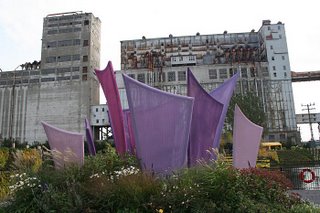
Imagine all of these unique, vibrant gardens, planted and thriving along the locks heading down to the mighty river. For a backdrop, the ancient grain elevators brood on the skyline, providing the perfect boundary on more than fifty different theme gardens.
There are tranquil gardens when you can pause and reflect...

...and gardens where you can actually delight in the designer's sense of humour

There are gardens with ecological themes, as with this water-conserving planting,

And gardens that are just plain whimsical
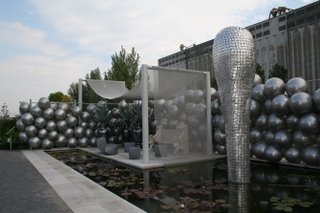
Now, I haven’t had time to review all the literature—or all the photographs I took—because oddly enough, I need some sleep! But on the train tomorrow, I’ll do up the photos from this afternoon’s visit to the next stop on the tour, and let you know more about the trip. This is just a teaser to get you started.
Subscribe to:
Posts (Atom)
Search Bloomingwriter

Custom Search
